C.M. Rosens's Blog, page 17
February 6, 2024
Conference Call for Papers 2024
This is an ENTIRELY ONLINE conference, so anyone can attend across different time zones. CFP is open until end of March.
Devils and Justified Sinners – 2024 Conference
February 3, 2024
Ricky News *Ko-Fi Update!
Briefly interrupting the fairytale series to let you know that I’ve opened up 2 more slots on my higher Ko-Fi tier – lower tier slots are also open. Check out what’s on offer! Lots of new stuff, including details of a Ricky-focused short story collection… keep reading for more details.
Dare to Peek at the eldritch horrors?View this post on InstagramWhat’s IncludedA post shared by C. M. Rosens (@cm.rosens)
You can check out the full list of all my posts (since 2021) here on this site: https://cmrosens.com/ko-fi-posts-masterlist/
Membership gets you access to all of these, plus you can download the following books for free:
Birds of a Feather – just for fun, a Ko-Fi exclusive novel set in a council estate, following the plot of The Crows (loosely) without the eldritch horror. Members get to see my drafting process for this, annotated with my thoughts and ideas, with a playlist, and the first post of that is here: https://ko-fi.com/post/AU-Carrie-Ricky-Part-1n-E1E4EE6NJ The Sussex Fretsaw Massacre – just for fun, a slasher short that features Ricky and Carrie trying to have a quiet night in on Halloween… but fate has other ideas. The audio version of this is on my podcast, free to listen, and the first episode is here. You can also find it across all podcast platforms (including Apple and Spotify, etc). The Reluctant Husband – a novelette featuring Nathan Porter and his descent into the darkness, via an ill-judged cup of tea, a housemaid, and her strangely squirming bosom. The Poetry of Betrayal – the backstory of Eglantine Pritchard (some of it, from 1904-1912), sketched out in another novelette. This is members only, and not for general sale . It links to the May 2023 card I sent out with some explanation as to how this fits with the lore and history of the characters, who so far have been all off-page.Last Year:Last year I ended 2023 with a series of letters from Katy, Carrie/Ricky, and Wes, exploring a possible plotline for Book 4 in the series. These posts are all available for new members to read and follow along with. This series started in July 2023, where Katy reveals she’s being stalked by something rather than someone, and was continued in August, where Ricky sent details of a ritual, September, where Carrie fills in some info and history/context, October, which also includes a snippet of prose featuring Katy’s encounter with a kind of parasitic Outer God, and was concluded in November, which featured Wes vs other Outer Gods as a prose snippet. In December, everyone received a Yule card from Carrie, with some hope that all is now resolved.
I’m looking at tying these ideas up into an actual coherent story, but let’s see, as I also have other ideas and I’m developing outlines now.
This Year:I’m writing a series of short stories from Ricky’s childhood, teens, and adulthood. I’ve already got one short story, “Gerald“, available to members – the first time Ricky (10 years old) met Myrddin, and how Gerald got his name. It was in the hardback edition of The Crows, which was a limited print run.
January’s story was “June“, and the beginning of the whole Wes/Ricky thing when they were 17. This is due to be continued in later months.
February’s story is “Poison”, set on Ricky’s 14th birthday. This comes with a postcard featuring an illustration from the original edition of The Crows and the artist Thomas S. Brown’s details, including a QR code link to his Patreon.
March-June will be similar: Ricky stories each month + a postcard mailed to higher tier members. Lower tier members get the digital versions on Ko-Fi.
These stories will be edited and compiled into a Ricky-focused collection that will go on sale as an eBook, but be free to members of both ‘Eldritch’ tiers to download in its final form.
Of course, if none of that appeals but you want to drop me a one-off tip, you can do that, or if you just want to drop me a monthly £1.00 in support of the podcast and its hosting costs, I’d appreciate that too. With that tier, you get access to older posts (the monthly posts from Nov 2021-Dec 2023) and a free eBook copy of The Reluctant Husband to download from my shop. To get new posts, you can upgrade to the Eldritch tiers at any time.
Most of all, thank YOU so much for supporting me and reading this post all the way to the end! You are deeply appreciated.
check out my Ko-Fi Membership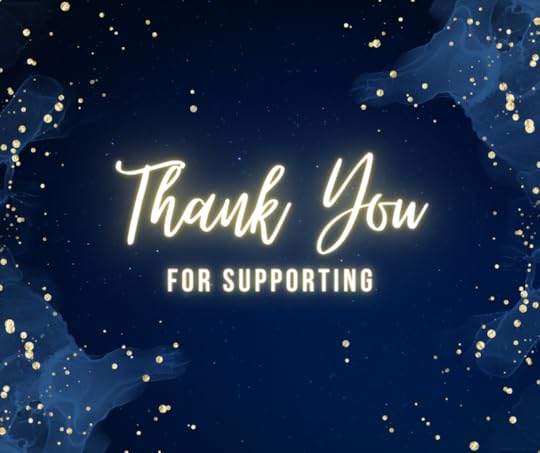
January 19, 2024
Bluebeard in Cinema 1901-2023
Bluebeard films: I was not prepared. My watchlist is overflowing. I don’t have enough hours in one life. I’ve realised while compiling the books and films for the Bluebeard posts that Yelen and Yelena is also a Bluebeard story. He has a room filled with the bodies of those who failed to break the curse, and made it to about six or seven in the 120 years that the rose bloomed.
There aren’t a lot of monster fuckers out there, but there are enough. It’s called the Rot Room.
So here we are with a few other BatB crossovers in the adaptations, and I wish I could find more! But this is probably enough for now!?
We’ve got serial killers galore – not all after their own wives – millionaire playboys, dodgy blokes set up as ‘romantic heroes’ amid a field of red flags, animations, claymation, you name it. I left off a Warner Bros cartoon with Porky Pig that is a Bluebeard story, but even Porky got to be in a Bluebeard adaptation. So did Red Ryder, in Texas Manhunt/Phantom of the Plains (1945), a 56min Western in which Ryder tries to convince a Duchess her new beau has a habit of murdering his wives. I’m mentioning that here rather than linking below as well.
Here’s one Letterboxd list that includes a few noir films I’m not sure about, but may fit the bill, and a few comedies like Hiss and Yell (1946).
I’ve given up on trying to order these so you’ve got them in chronological order from 1901-2023.
Not all the films with the title ‘Bluebeard’ set out to be faithful to the story, of course, but they all play with and nod to it. I’ve not seen them all! Intermixed with these are films that definitely have some sort of Bluebeard theme in there, and I’m including adaptations of classic novels Jane Eyre and Rebecca for this reason.
However: I absolutely refuse to include ALL the adaptations of Jane Eyre because the first one was 1910, that’s right, 1910, and then there are MILLIONS of them after that. Ok, not millions, 19. Still too many. But this includes the Indian and Greek ones, plus all the miniseries versions. Check here where someone has ranked all 19 different versions: https://letterboxd.com/loureviews/list/ranking-the-jane-eyre-films/.
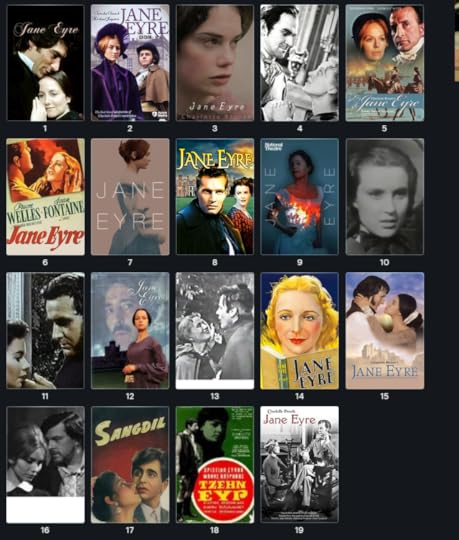
The above graphic is the films ranked by that viewer’s preference, 1 being their favourite, and 19 being the least favourite, although they all got 3 stars or above.
(I personally would give an extra star for the Greek phonetic spelling of her name. Τζέιν Έιρ (1968) didn’t make it into a Greek film I don’t think?? I think it’s still set in England, with the characters just being Greek speaking, but not sure.)

I can only find about 5 versions of Rebecca on Letterboxd, although I wasn’t looking too hard. There’s Hitchcock’s classic version (1940), Simon Langton’s version (1979), Jim O’Brien’s version with Charles Dance (1997), Francesca Zambella’s version which sticks pretty closely to the original novel (2006), and Ben Wheatley’s most recent version for Netflix (2020). I’ve put some of these below.
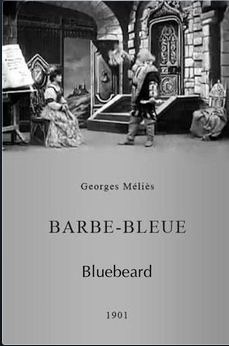
Barbe-bleue / Bluebeard (1901) dir. Georges Méliès – [Silent Film] A young woman becomes the eighth wife of the wealthy Bluebeard, whose first seven wives have died under mysterious circumstances.
You can watch this one on YouTube, it’s pretty short (around 10mins runtime)! I’ve linked one below with background piano music.
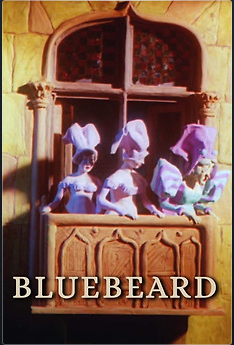
Barbe-bleue / Bluebeard (1936) dir. Jean Painlevé, René Bertrand – Perrault’s fairy tale presented in claymation with choral voices.
Bluebeard goes courting, all six of his wives having died. He arrives at the house of a widow with two daughters. He’s greatly feared, but he overcomes objections with a generous dowry. One sister (Anne) refuses him; the other accepts. At his castle, the damsel delights in precious minutes away from Bluebeard in the rose garden. The Saracens declare war; Bluebeard goes off to fight them, leaving the keys to the castle in the damsel’s hands. He warns her not to enter the forbidden room. As war rages, she discovers riches in the castle and then enters the forbidden room.
Will Bluebeard discover her act? Can she escape death?
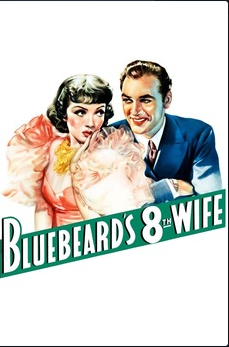
Bluebeard’s Eighth Wife (1938) dir. Ernst Lubitsch – HE MARRIED IN HASTE AND REPEATED IN PLEASURE! American multi-millionaire Michael Brandon marries his eighth wife, Nicole, the daughter of a broken French Marquis. But she doesn’t want to be only a number in the row of his ex-wives and starts her own strategy to tame him.
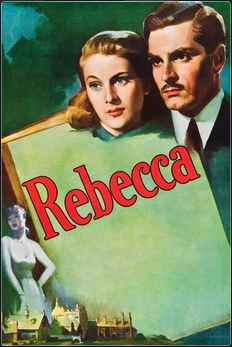
Rebecca (1940) dir. Alfred Hitchcock – THE SHADOW OF THIS WOMAN DARKENED THEIR LOVE. Story of a young woman who marries a fascinating widower only to find out that she must live in the shadow of his former wife, Rebecca, who died mysteriously several years earlier. The young wife must come to grips with the terrible secret of her handsome, cold husband, Max De Winter. She must also deal with the jealous, obsessed Mrs. Danvers, the housekeeper, who will not accept her as the mistress of the house.
This is currently on YouTube and linked below:
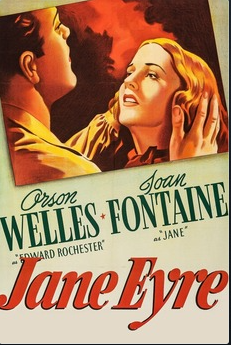
Jane Eyre (1943) dir. Robert Stevenson – A LOVE STORY EVERY WOMAN WOULD DIE A THOUSAND DEATHS TO LIVE! After a harsh childhood, orphan Jane Eyre is hired by Edward Rochester, the brooding lord of a mysterious manor house to care for his young daughter.
This is currently on YouTube and linked below:
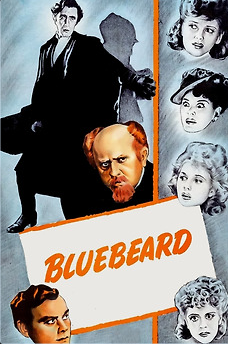
Bluebeard (1944) dir. Edgar G. Ulmer – THE MOST SINISTER LOVE STORY EVER TOLD! Young female models are being strangled. Will law enforcement be able to stop the crime wave before more women become victims?
This is currently on YouTube and linked below:
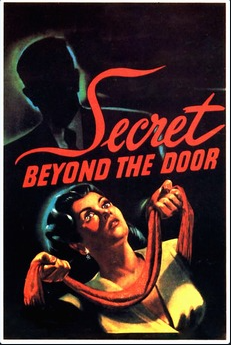
Secret Beyond the Door (1947) dir. Fritz Lang – SOME MEN DESTROY WHAT THEY LOVE MOST!
After a whirlwind romance in Mexico, a beautiful heiress marries a man she barely knows with hardly a second thought. She finds his New York home full of his strange relations, and macabre rooms that are replicas of famous murder sites. One locked room contains the secret to her husband’s obsession, and the truth about what happened to his first wife.
This is currently on YouTube and also available to buy/rent:
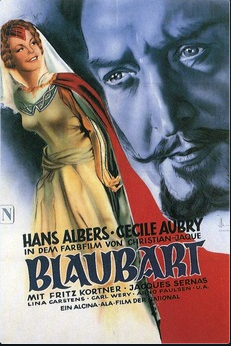
Barbe-bleue / Bluebeard (1951) dir. Christian-Jaque – [This is a comedy, not too raunchy because it’s the 1950s, but you can probably guess the twist a mile away.]
Just before wowing international critics and moviegoers with his adventure romp Fanfan la Tulipe, director Christian-Jaque dashed off the lampoonish Barbe-Bleue. Ostensibly the story of the famed wife-killing potentate Bluebeard (Pierre Brasseur), this lighthearted costumer begins as the title character is poised to march down the matrimonial aisle for the eighth time. Barbe-Bleue’s newest spouse Aline (Cécile Aubry) is kept in line by her husband’s claims of murdering her predecessors. But when Aline opens the famous locked door to the equally famous hidden room, both she and the audience are in for quite a surprise. The frivolous nature of Barbe-Bleue is underlined by its pleasing utilization of the French Gezacolor process.
This is currently on YouTube and linked below, but it’s in the original French without subtitles. If you read French better than you hear it, there’s a transcript, but it’s auto-generated and imperfect:
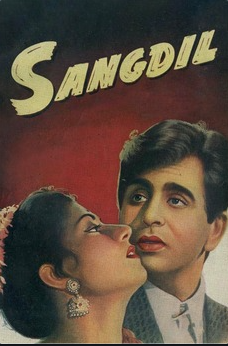
Sangdil (1950) dir. R. C. Talwar – A loose adaptation of Charlotte Bronte’s classic, Jane Eyre. In this version childhood sweethearts are separated and grow up in different worlds. The girl is brought up to be a ‘pujaaran’ (priestess) while the boy grows up to be a dejected ‘thakur’, turned vindictive by life’s injustices. Fate inevitably brings them together at a later juncture, and all seems happy and perfect for the young couple, until she discovers his deep, dark secret.
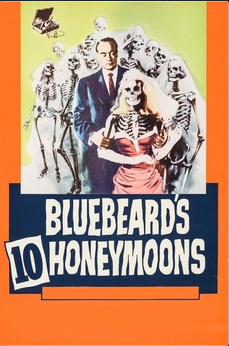
Bluebeard’s 10 Honeymoons (1960) dir. W. Lee Wilder – THE MAN WITH THE DO-IT-YOURSELF MURDER KIT! A murderer enriches his finances by marrying and then killing off a series of wealthy women.
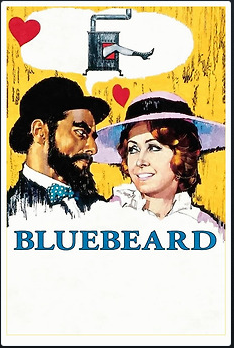
Landru/Bluebeard (1963) dir. Claude Chabrol – THE MOST SHOCKING SCANDAL PARIS EVER SAW!
Paris, France, during the First World War. While thousands of soldiers die every day on the battlefields, Henri Landru, a seemingly respectable furniture dealer, married and father of four children, relentlessly feeds his own sinister factory of death.
One Letterboxd review describes it better than the blurb does:
One of the few features of famed French director Claude Chabrol that doesn’t take place primarily in his beloved French countryside, “Landru” is nonetheless another typical middle class satire for which he was renowned. The ease with which somebody as deranged as the protagonist manages to find and con so many seemingly smart and educated women, and his confidence that he can get away with it because of his status as a respectable and erudite family man, are a none-too-subtle metaphor for the ease with which French society falls victim to charismatic politicians and business leaders who are later exposed as frauds. Despite the gruesomeness of Verdu’s crimes Chabrol’s ironic humor doesn’t let the mood become too grim.
Letterboxd User Panos75: https://letterboxd.com/panos75/film/bluebeard-1963/
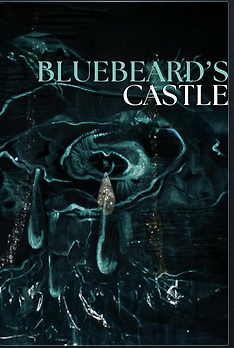
Herzog Blaubarts Burg/Bluebeard’s Castle (1963) dir. Michael Powell – Based on the Béla Bartók opera, Duke Bluebeard reluctantly and gradually uncovers the secrets of his psyche to his fourth wife, Judit, opening the seven doors of his castle to ultimately reveal his still living previous wives, among whom Judit must take her place.
I actually love this and the way it’s shot and staged, and the scenery and the music. I haven’t seen it live but I would really like to.
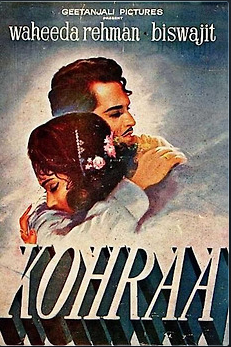
कोहरा/Kohraa (1964) dir. Biren Nag – In this re-imagining of Du Maurier’s Rebecca, a recently wed woman discovers the ghost of her husband’s first wife still haunts their home.
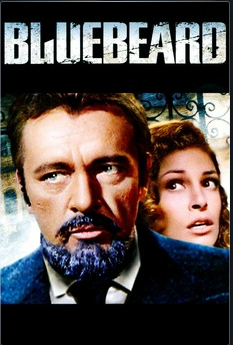
Bluebeard (1972) dir. Edward Dmytryk – [Starring Richard Burton!] HE HAD A WAY WITH THE WORLD’S MOST BEAUTIFUL, MOST SEDUCTIVE, MOST GLAMOROUS WOMEN …HE DID AWAY WITH THEM.
Baron von Sepper is an Austrian aristocrat noted for his blue-toned beard, and his appetite for beautiful wives. His latest spouse, an American beauty named Anne, discovers a vault in his castle that’s filled with the frozen bodies of several beautiful women.
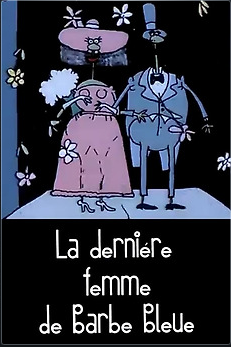
La dernière femme de Barbe Bleue / Bluebeard’s Last Wife (1996) dir. Aleksandr Bubnov – [Animation] A new version of the famous story about Bluebeard. Two characters – killers from different eras, from different myths – decide to start a family. Who will win in a deadly duel? Another attempt to get married will be the last for the hero…
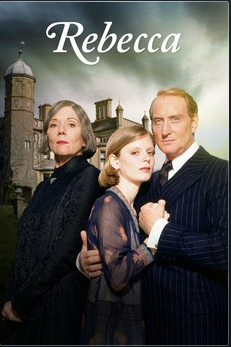
Rebecca (1997) dir. Jim O’Brien – Based on the Gothic romance novel by Daphne Du Maurier, Rebecca is a classic tale of love and hate. Maxim De Winter marries a woman half his age only a year after his first wife, the beautiful and accomplished Rebecca, dies. She finds herself in an aristocratic social world her middle class upbringing did not prepare her for, and housekeeper Mrs Danvers despises her for taking her darling Rebecca’s place. But these are not the only problems to face…
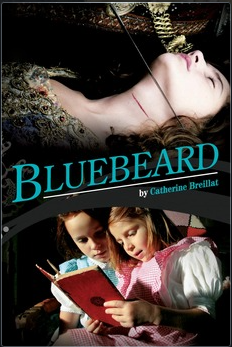
Barbe Bleue / Bluebeard (2009) dir. Catherine Breillat – Anne (Daphné Baiwir) reads her younger sister, Marie-Catherine (Lola Créton), the story of Bluebeard. In 17th-century France, another set of sisters — also named Anne and Marie-Catherine — are left impoverished by their father’s death. Marie-Catherine dreams of marrying into money, and soon falls for wealthy divorcé Bluebeard (Dominique Thomas). Grateful for the chance at a life of comfort, Marie-Catherine marries Bluebeard — in spite of rumors that he has made a hobby of murdering his wives.
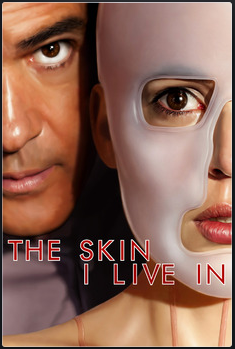
La piel que habito/The Skin I Live In (2011), dir. Pedro Almodóvar – A brilliant plastic surgeon creates a synthetic skin that withstands any kind of damage. His guinea pig: a mysterious and volatile woman who holds the key to his obsession.
This is one Almodóvar film I haven’t seen – medical horror/surgical horror genuinely freaks me out and his directing style gets under my skin so that’s not a combination I really want to cope with. However, it was recommended as a Bluebeard film! So I shall put it here and let people discuss!
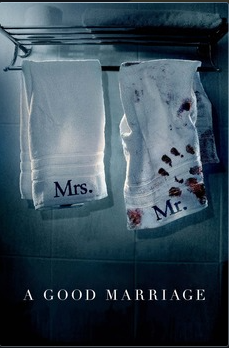
A Good Marriage (2014) dir. Peter Askin – Based on the Stephen King novella.
TWO CAN KEEP A SECRET… IF ONE OF THEM IS DEAD.After 25 years of a good marriage, what will Darcy do once she discovers her husband’s sinister secret?

Ex Machina (2015) dir. Alex Garland – THERE IS NOTHING MORE HUMAN THAN THE WILL TO SURVIVE. Caleb, a coder at the world’s largest internet company, wins a competition to spend a week at a private mountain retreat belonging to Nathan, the reclusive CEO of the company. But when Caleb arrives at the remote location he finds that he will have to participate in a strange and fascinating experiment in which he must interact with the world’s first true artificial intelligence, housed in the body of a beautiful robot girl.
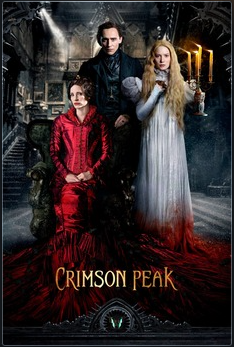
Crimson Peak (2015) dir. Guillermo del Toro – LOVE MAKES MONSTERS OF US ALL. In the aftermath of a family tragedy, an aspiring author is torn between love for her childhood friend and the temptation of a mysterious outsider. Trying to escape the ghosts of her past, she is swept away to a house that breathes, bleeds… and remembers.
This is the best version of Bluebeard for me. It’s just so good. I really want a rich, lush, dark fantasy version – like the Beauty and the Beast treatment of a gorgeous, stunning Gothic mausoleum of a castle, and the gore and horror of Bluebeard. The closest thing I’ve found so far is this one.
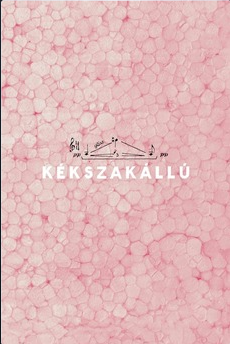
Kékszakállú, (2016), dir. Gastón Solnicki – An unconventional portrayal of several young women witnessed in immersive yet indeterminate states: within their bodies, among their friends and lovers, and ultimately in a culture of economic and spiritual recession. Obliquely inspired by Bela Bartok’s sole opera, Bluebeard’s Castle.
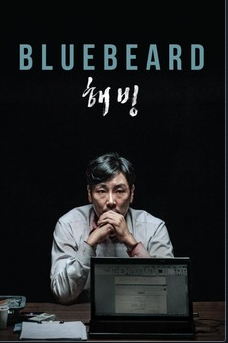
해빙 / Bluebeard, (2017) Lee Soo-Youn – A BEAST EXISTS WITHIN US ALL.
A doctor finds himself in the middle of an unsolved serial murder case after discovering a secret from a sedated patient. When dismembered bodies show up close to home, he must solve the riddle before the killer realizes what he knows.
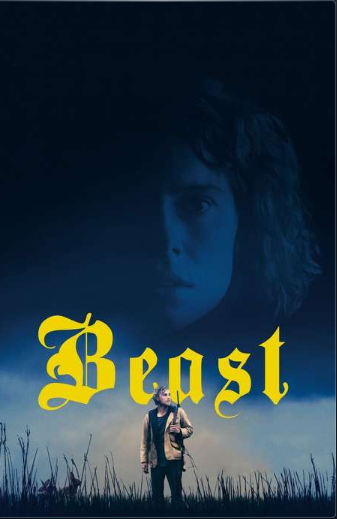
Beast (2017) dir. Michael Pearce – I already put this as a BatB version, but there’s a lot of overlap and I think it fits the Bluebeard theme better! So here it is again!
A troubled woman living in an isolated community finds herself pulled between the control of her oppressive family and the allure of a secretive outsider suspected of a series of brutal murders.
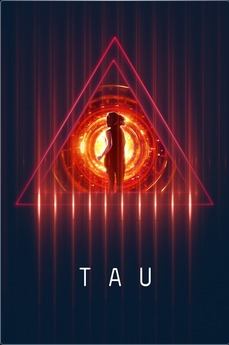
Tau (2018) dir. Federico D’Alessandro – NO BARS. NO GUARDS. NO ESCAPE. Held captive in a futuristic smart house, a woman hopes to escape by befriending the A.I. program that controls the house.
Ok, I’m including this as the “bride” figure wakes up as an experiment in the secret dungeon of Alex (Ed Skrein), only to find that his experiments do not survive and she’s not the first. She is determined to be the last. But actually, the real bride figure is Tau, the AI servant, voiced by Gary Oldman. Tau’s “door” it mustn’t open is one of wider knowledge and understanding of the outside world and of itself, and an understanding that Alex, its master, is not a ‘good’ person. Julia (Maika Monroe) is the one who helps Tau to open it, and save them both through its ability to make new decisions.
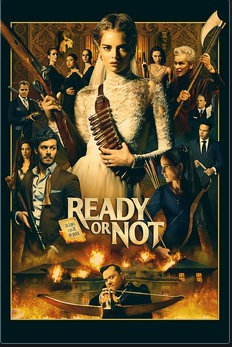
Ready or Not (2019) dir. Matt Bettinelli-Olpin, Tyler Gillett – IN-LAWS CAN BE MURDER. A bride’s wedding night takes a sinister turn when her eccentric new in-laws force her to take part in a terrifying game.
I’d say this one counts as it has the innocent bride discovering a grisly secret about her husband and the family she is marrying into. Anyone who marries into the family must play a game, and sometimes that game is … deadly.
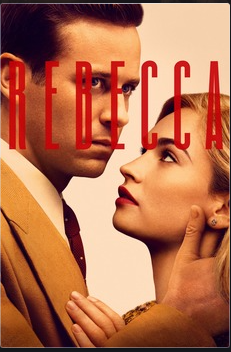
Rebecca (2020) dir. Ben Wheatley – [They weirdly made this a romance… it’s not actually romantic as a story, but ok] After a whirlwind romance with a wealthy widower, a naïve bride moves to his family estate but can’t escape the haunting shadow of his late wife.
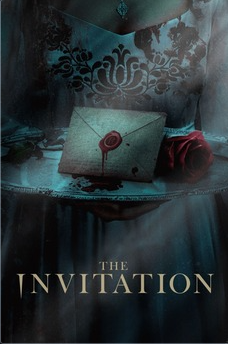
The Invitation (2022) – YOU ARE CORDIALLY INVITED TO A NIGHTMARE GENERATIONS IN THE MAKING. After the death of her mother, Evie is approached by an unknown cousin who invites her to a lavish wedding in the English countryside. Soon, she realizes a gothic conspiracy is afoot and must fight for survival as she uncovers twisted secrets in her family’s history.
This one counts as well – there’s a wedding and the dark history of the family, which definitely includes bloody murder.
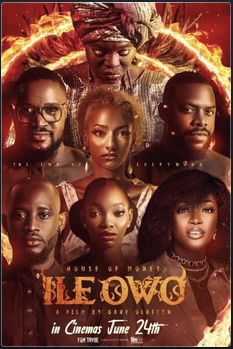
Ile Owo/House of Money (2022) dir. Dare Olaitan – Busola has forever been unlucky with love. Pressured by society and her parents to tie the knot as a means to lift her family out of poverty, she finally meets Tunji – the perfect man. At first, Busola struggles to understand why a billionaire would choose to marry her, but after she accepts his proposal of marriage, a series of increasingly disturbing discoveries lead her to a truth she could never have imagined.
I loved this one. It’s a ‘strange suitor’ folktale type, and has that dark adult fairytale feel. I absolutely love Busola’s mum, who tries so hard to keep Busola safe while the men in the story – including her own father – force her into terrible situations.
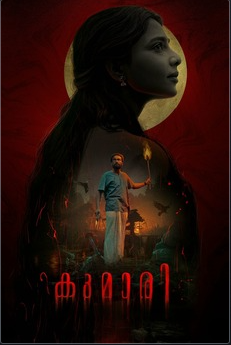
കുമാരി / Kumari (2022) dir. Nirmal Sahadev – Kumari is married off to Dhruvan of Kanjirangattu Tharavadu, a cursed land beyond Illmayi, in the west. As Kumari finds her comfort zone in her new family which is heavy with mystery, myths and superstitions, she also realizes that the people over there are blinded by faith and sorcery, ready to sacrifice their lives to preserve tradition, prosperity and peace.
This one was a good watch and really uncomfortable in places, genuinely creepy and tense in others. I really enjoyed it. The whole family are in on the dark secret here, much like Ready or Not, but the slow descent of Dhruvan is the worst thing to watch because you can see it’s going to get really bad for her by the end. I really liked the climax and the whole story.
PollVote below for the next story!
January 17, 2024
January Update
You're currently a free subscriber. Upgrade your subscription to get access to the rest of this post and other paid-subscriber only content.
Upgrade subscriptionJanuary 16, 2024
The Dangers of Blue Beards (in Books)
As I’m sure you all know I’m not a folklorist or anything like that, but I LOVE folktales and stories, and I think in worldbuilding one of the best and most fun ways to get to grips with a culture is by imagining what stories people tell about themselves and their world. In The Crows I made up local legends and sayings, and put out a little eBook collection of hyperlocal folktales ‘collected’ from the area called Folklore of Pagham-on-Sea. which you can get for 99p from eBook stores, Amazon, or directly from me (preferred if possible!)
I’m making up whole myths and belief systems for my Yelen & Yelena fantasy world, and really enjoying that process. Each chapter is prefaced by some snippets of these, as I wanted to give that flavour without being too heavy-handed in the text, and you can always skip over them.
That disclaimer aside, I am continuing this series of posts on real world folktales and their retellings/reimaginings with Bluebeard, as this tale won the poll in the previous post – so here we are!
The first section of this post is a short look at different types of tale and some links to versions across the world, and then the second section is the retellings/reimaginings section!
Bluebeard Tales and VariationsEssentially, this tale is about a woman who marries a strange man, only to find he’s a serial killer. This discovery can take place in a few different ways, depending on the variation of the tale, but the ‘classic’ one is where she’s told not to open a specific door in his castle. She does, obviously, while he’s away, and discovers the grisly remains of his previous wives in the room. Fortunately, despite getting blood on herself or the key which gives her away, she manages to escape. In some versions, like the English ‘Mr Fox’, she hides somewhere and sees him dragging his victims into the castle, and manages to cut off the victim’s hand to present as proof the next day when she confronts him with her male relatives.
In terms of folk ballads, the Scottish “Lady Isabel and the Elf Knight” is definitely one I’d class as a similar type to this. Lady Isabel is intrigued (or entranced) by an Elf knight blowing his horn, and rides off with him to the greenwood. There he tells her that he has slain seven of his brides already and she will be the eighth of them. Isabel lulls him to sleep in her lap and slays him with his own dagger, and rides off home. In some versions, her pet parrot sees her coming back and threatens to tell on her to her parents.
Steeleye Span in concert 1995You can find a full list of the specific Aarne/Thompson/Uther index type here, which includes tales from around the world, including the USA (including an African-American version), and various parts of Europe. For “Mr Fox” and similar tales, classified as a different type, there’s a list here. Watch out for antiziganism in there, particularly the English/European ones.
For the purposes of this post, as Bluebeard and Mr Fox are really similar thematically, I’m going to merge these for this post, and do both types at once.
There are a number of printed versions of Bluebeard from Perrault’s 1697 version onwards, and in the 18thC, amid the trend for ‘Orientalism‘, a play version positioning the tale in Turkey and making Bluebeard a racial Other, playing into fears and prejudices of the audience, was a big hit. This trend for Bluebeard’s casting in various artistic interpretations of the tale persisted well into the 20thC.
I’m struggling to find a [free, open access] Turkish masal/fairytale equivalent in English, but here’s a collection of tales from Turkey by Ignácz Kúnos, trans. R. Nesbit Bain.
Some Turkish tales, like Altmış Akıllı Yetmiş Fikirli (Sixty Brains, Seventy Aims) might qualify, as here a selfish mother gives her daughter to a complete stranger (seeing a chance to improve her social position), who tests the young woman with locked doors she mustn’t open. However, the young woman is smart enough to not open the door, averting a tragic end, but in doing so remains subjugated to her mother and husband and subject to their wills and whims.
This tale and others is discussed in Dr. Gül Büyü’s PhD 2013 thesis, Evil in Fairy Tales Across Cultures: A Study of Turkish and British Fairy Tales from a Psychological Perspective. This is free to download, and in English. More publications by Dr Büyü are here.
Charles Perrault’s version of Bluebeard is here. The English version, Mr Fox, is here. There are a ton of ‘Strange Suitor’ tales like this across Africa too, and here is a podcast from Mythological Africans talking about tales from Cameroon, Nigeria, Sierra Leone, Chad and Namibia, although I’m not sure if these are in the same classification of the Aarne/Thompson/Uther folktales, but want to highlight them because I think they count, and because some Nollywood films based on them will work for the ‘Bluebeard in horror cinema’ post!! In the Caribbean, tales that do fit this type include The Chosen Suitor (Antigua) and Man-Snake as Bridegroom (Jamaica). In India, there are stories like The Brahmin Girl That Married a Tiger.
I think I might also say that if we’re going loose and you want to gender-flip it, then the tales of men marrying fox spirits and demon-wives in folktales from different parts of Asia would work too? Maybe tales like Lady Tamamo in ‘The Jewel Maiden’ (Japan) would fit, but in that case the secret isn’t that she kills all her husbands, but she is causing the sickness of the Emperor.
Your Retelling/Reimagining Recs!There’s a GoodReads list for everything, and this tale is no exception: here’s one list and here’s another! The second list has a lot of pulp Gothic Romances on it, and some pulp noir, and you’ll be unsurprised to discover that this tale formed the basis for QUITE A LOT of those plots! Tor has a short list here too.
Dr Sam Hirst’s blog has a Bluebeard post for their October series, A Scare A Day (2023), on Day 28! The story set for Day 28 was Bluebeard’s Wife by T. Kingfisher (also mentioned and linked below). There is a list of 10 versions in this post, including poetry, that also have the Bluebeard theme! Where they are available to read online, they are linked.
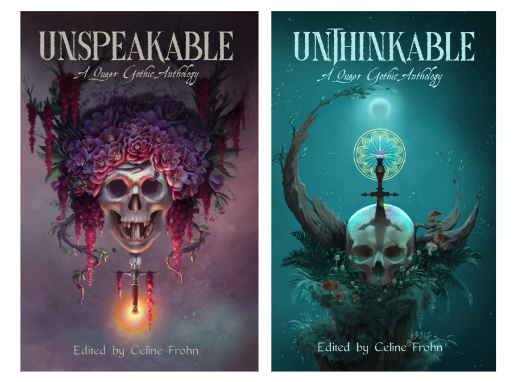
You will also find some great queer Gothic reimaginings of various tales – as well as original fiction – in the anthologies Unspeakable and Unthinkable from Haunt Publishing, ed. Celine Frohn.
One of the Bluebeard tales is “The White Door” by Lindsay King-Miller, and is in Unspeakable. It’s sapphic and with vampires!
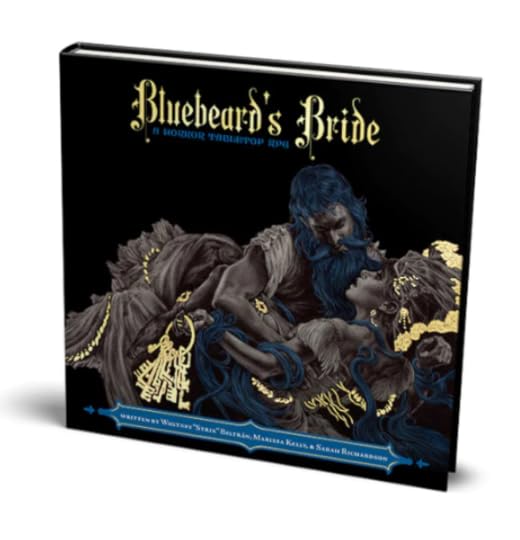
There is also a RPG from Magpie Games called Bluebeard’s Bride, and that deserves a mention as it was recommended as a game!
Will You Open The Final Door?
A young bride is wed to an ugly, but powerful man with a blue beard. He invites her to explore the house… but one room is forbidden. Eventually the young bride falls prey to her curiosity and opens it, discovering the gruesome display of former brides murdered…
Explore Bluebeard’s mansion and create your own beautifully tragic version of the dark fairy tale. Experience the nightmarish memories that haunt the rooms of this broken place and discover the truth of what happened here. But it is up to you and your friends to decide whether or not you are a faithful or disloyal bride.
Bluebeard’s Bride, an investigatory horror tabletop roleplaying game for 3-5 people, based on the Bluebeard fairy tale.
Here are a mix of recommended versions from you, and some I’ve found/read/on my TBR. I’ve copied the blurbs/descriptions from GoodReads and Amazon where I can find them.
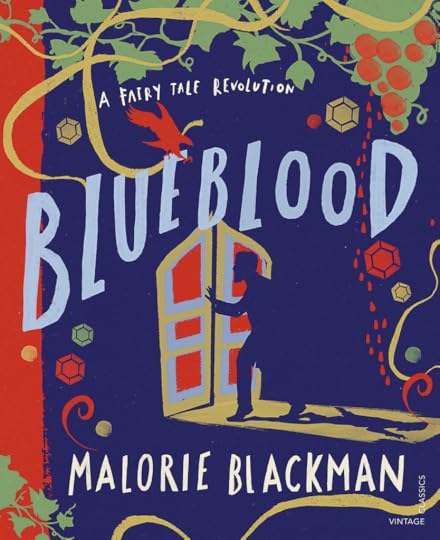
Blueblood by Malorie Blackman – A short story retelling.
Nia has met the man she wants to marry. Marcus is kind, clever and handsome, with a beard so dark it is nearly blue-black. Nia demands a single promise from him – that Marcus will never enter her study in the basement, her private space. But when Marcus’s curiosity begins to mount Nia feels more and more uneasy. Will he betray her? Can he accept that no means no? Can a woman ever have a room of her own?
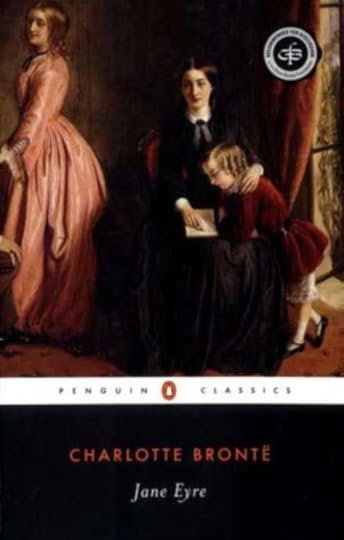
Jane Eyre by Charlotte Bronte appears again as it evokes Bluebeard in the text – and Rochester does indeed have a wife locked in the secret room! The secret is something that nearly costs Jane her life (metaphorically), and after discovery she flees Thornfield…
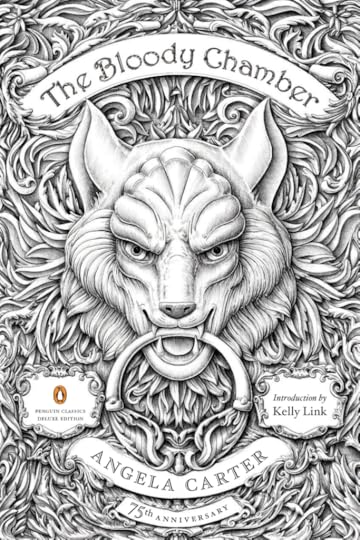
The Bloody Chamber by Angela Carter – we can’t escape Carter, so here she is again! This one is pretty much a classic Bluebeard retelling now, so it can’t be left off. She also wrote “Bluebeard” in the collection of short fairy tale retellings named after it.
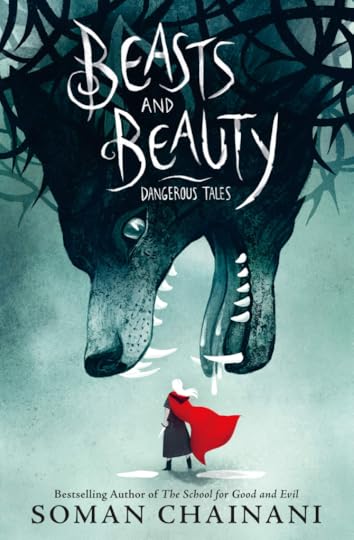
“Bluebeard” by Soman Chainani in the collection Beasts and Beauty: Dangerous Tales, where the protagonist is a young orphan boy, Pietro, going up against a powerful noble who has invited him in to be his guest and victim. (This is for younger readers).
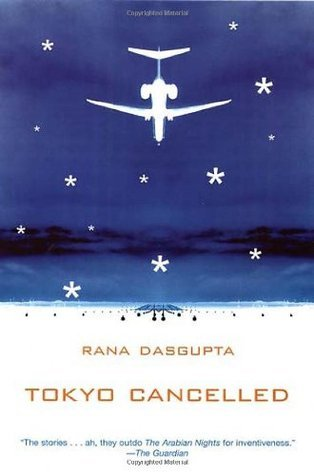
Tokyo Cancelled by Rana Dasgupta – a framed narrative where strangers in an airport, connected by a cancelled flight to Tokyo, tell each other stories to pass the time. One of these tales is a Bluebeard type story, in which a Turkish girl is left alone in the house of a German map-maker.
Thirteen passengers are stranded at an airport. Tokyo, their destination, is covered in snow and all flights are cancelled. To pass the night they form a huddle by the silent baggage carousels and tell one another stories. Thus begins Rana Dasgupta’s Canterbury Tales for our times.
In the spirit of Borges and Calvino, Dasgupta’s writing combines an energetically modern landscape with a timeless, beguiling fairy-tale ethos, while bringing to life a cast of extraordinary individuals-some lost, some confused, some happy-in a world that remains ineffable, inexplicable, and wonderful.
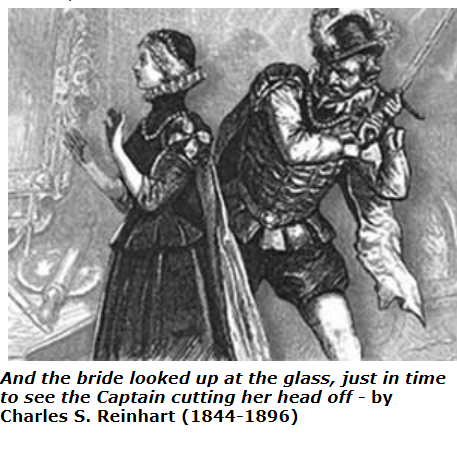
Captain Murderer by Charles Dickens – Dickens recalls the story of Captain Murderer, a story that his nurse would terrify him with as a child:
“The young woman who brought me acquainted with Captain Murderer had a fiendish enjoyment of my terrors, and used to begin, I remember–as a sort of introductory overture–by clawing the air with both hands, and uttering a long low hollow groan. So acutely did I suffer from this ceremony in combination with this infernal Captain, that I sometimes used to plead I thought I was hardly strong enough and old enough to hear the story again just yet. But, she never spared me one word of it.”
First published in Dickens’ weekly magazine All the Year Round on September 8, 1860.
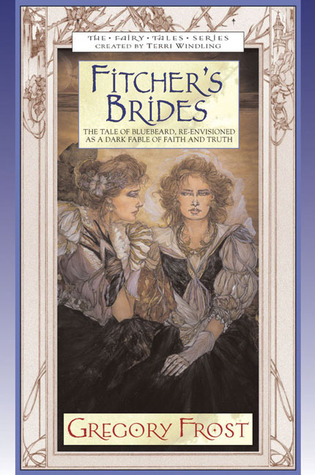
Fitcher’s Brides by Gregory Frost – The tale of Bluebeard, reenvisioned as a dark fable of faith and truth
1843 is the “last year of the world,” according the Elias Fitcher, a charismatic preacher in the Finger Lakes district of New York State. He’s established a utopian community on an estate outside the town of Jeckyll’s Glen, where the faithful wait, work, and pray for the world to end.
Vernelia, Amy, and Catherine Charter are the three young townswomen whose father falls under the Reverend Fitcher’s hypnotic sway. In their old house, where ghostly voices whisper from the walls, the girls are ruled by their stepmother, who is ruled in turn by the fiery preacher. Determined to spend Eternity as a married man, Fitcher casts his eye on Vernelia, and before much longer the two are wed. But living on the man’s estate, separated from her family, Vern soon learns the extent of her husband’s dark side. It’s rumored that he’s been married before, though what became of those wives she does not know. Perhaps the secret lies in the locked room at the very top of the house—the sin-gle room that the Reverend Fitcher has forbidden to her.
Inspired by the classic fairy tales “Bluebeard” and “The Fitcher Bird,” this dark fantasy is set in New York State’s “Burned-Over District,” at its time of historic religious ferment. All three Charter sisters will play their part in the story of Fitcher’s Utopia: a story of faith gone wrong, and evil countered by one brave, true soul.
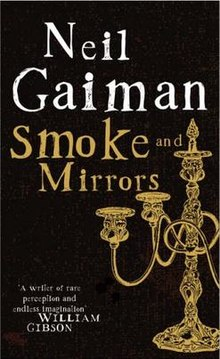
“The White Road” is a short story by Neil Gaiman published in Smoke and Mirrors, a collection of short stories. This one is a retelling of English folktale, ‘Mr Fox’.
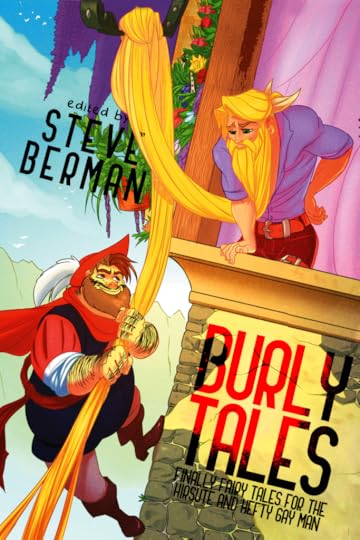
“Something Old, Something New, Something Borrowed, Something Blue” by Jonathan Harper in Burly Tales: Finally, Fairy Tales for the Hirsute and Hefty Gay Man, ed. Steve Burman – a Bluebeard retelling for a gay anthology.
“This anthology of romances, adapted from fairy tales and fables, runs the gamut: from short stories to poetry, from contemporary settings to fantasy, from humorous to serious; all of them celebrate the beauty of large, hairy men.” – Library Journal, starred review.
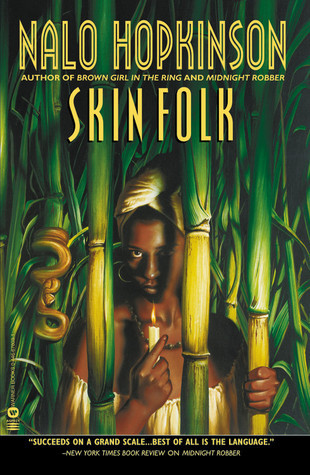
“The Glass Bottle Trick” by Nalo Hopkinson, a short story from the collection Skin Folk. In it, a man hangs up glass bottles to prevent his dead wives returning to look for their bodies. CW: domestic abuse.
The award-winning author of Brown Girl in the Ring and Midnight Robber presents a powerful new collection of short fiction that draws on the folklore and legends of the Caribbean in sensual and disturbing tales that capture the dark worlds of the soucouyant (vampire) and lagahoo (werewolf).
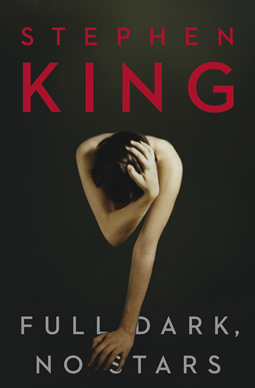
A Good Marriage by Stephen King – a novella published in the collection Full Dark, No Stars, which contains 4 King novellas. It is a film of the same name (2014) dir. Peter Askin, and will be featured in the cinema post (next!)
Darcy Anderson learns more about her husband of over twenty years than she would have liked to know when she stumbles literally upon a box under a worktable in their garage.
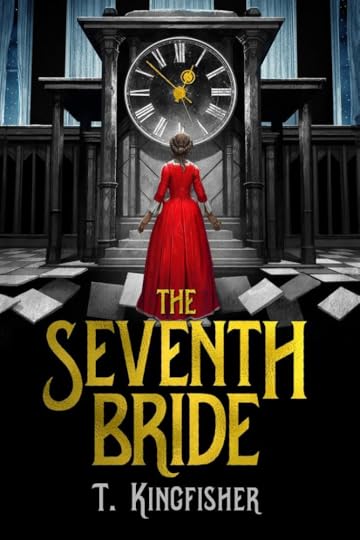
The Seventh Bride by T. Kingfisher – Young Rhea is a miller’s daughter of low birth, so she is understandably surprised when a mysterious nobleman, Lord Crevan, shows up on her doorstep and proposes marriage. Since commoners don’t turn down lords—no matter how sinister they may seem—Rhea is forced to agree to the engagement.
Lord Crevan demands that Rhea visit his remote manor before their wedding. Upon arrival, she discovers that not only was her betrothed married six times before, but his previous wives are all imprisoned in his enchanted castle. Determined not to share their same fate, Rhea asserts her desire for freedom. In answer, Lord Crevan gives Rhea a series of magical tasks to complete, with the threat “Come back before dawn, or else I’ll marry you.”
With time running out and each task more dangerous and bizarre than the last, Rhea must use her resourcefulness, compassion, and bravery to rally the other wives and defeat the sorcerer before he binds her to him forever.
Kingfisher also wrote the short story Bluebeard’s Wife (free to read in Fireside Magazine, linked) in which his wife never finds the room until after his death, and they had a long and happy marriage due to her blissful ignorance.
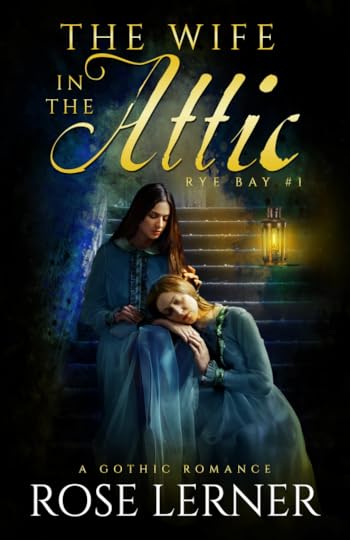
The Wife in the Attic by Rose Lerner is more a Bluebeard tale than Beauty and the Beast, so it goes in here as well!
Goldengrove’s towers and twisted chimneys rose at the very edge of the peaceful Weald, a stone’s throw from the poisonous marshes and merciless waters of Rye Bay. Young Tabby Palethorp had been running wild there, ever since her mother grew too ill to leave her room.
I was the perfect choice to give Tabby a good English education: thoroughly respectable and far too plain to tempt her lonely father, Sir Kit, to indiscretion.
I knew better than to trust my new employer with the truth about my past. But knowing better couldn’t stop me from yearning for impossible things: to be Tabby’s mother, Sir Kit’s companion, Goldengrove’s new mistress.
All that belonged to poor Lady Palethorp. Most of all, I burned to finally catch a glimpse of her.
Surely she could tell me who had viciously defaced the exquisite guitar in the music room, why all the doors in the house were locked after dark, and whose footsteps I heard in the night…
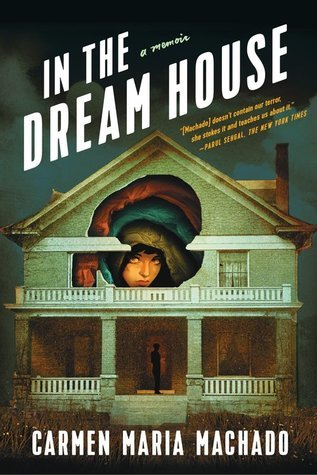
In the Dream House by Carmen Maria Machado has a sapphic Bluebeard story in her memoir, ‘Dream House as Bluebeard’.
For years Carmen Maria Machado has struggled to articulate her experiences in an abusive same-sex relationship. In this extraordinarily candid and radically inventive memoir, Machado tackles a dark and difficult subject with wit, inventiveness and an inquiring spirit, as she uses a series of narrative tropes—including classic horror themes—to create an entirely unique piece of work which is destined to become an instant classic.
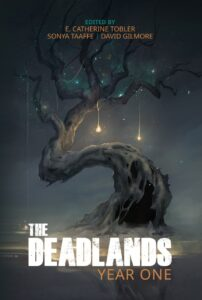
Immolatus by Lyndsie Manusos, in Deadlands magazine. This one is told from the perspective of the brides and their ghosts! In this retelling there are 4 brides in total: the Iron Maiden, the Hungry Warrior and the Lover have their sections, and the last bride is a musician, faced with the prospect of joining the other three – but not if the ghosts can help it.
A good short read.
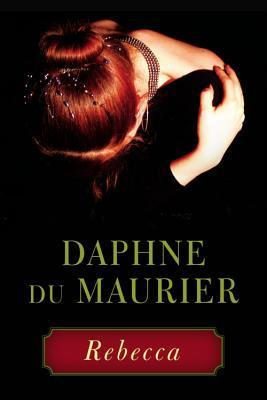
Rebecca by Daphne Du Maurier – “Last night I dreamt I went to Manderley again…”
Ancient, beautiful Manderley, between the rose garden and the sea, is the county’s showpiece. Rebecca made it so – even a year after her death, Rebecca’s influence still rules there. How can Maxim de Winter’s shy new bride ever fill her place or escape her vital shadow?
A shadow that grows longer and darker as the brief summer fades, until, in a moment of climatic revelations, it threatens to eclipse Manderley and its inhabitants completely…

From the Memoirs of Mme. B— by Elizabeth R. McClellan is a poem that tells the story of the surviving wife, posted on Corvid Queen. CONTENT NOTES: descriptions of violence, unwanted sexual encounters.
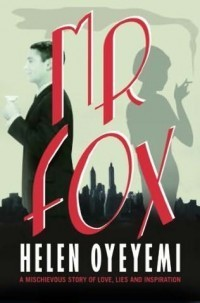
Mr Fox by Helen Oyeyemi – this one gets meta, and is based on the English folktale equivalent for Bluebeard, ‘Mr Fox‘.
It’s a bright afternoon in 1938 and Mary Foxe is in a confrontational mood. St John Fox, celebrated novelist, hasn’t seen her in six years. He’s unprepared for her afternoon visit, not least because she doesn’t exist. He’s infatuated with her. But he also made her up.
“You’re a villain,” she tells him. ‘A serial killer . . . can you grasp that?”
Will Mr Fox meet his muse’s challenge, to stop murdering his heroines and explore something of love? What will his wife Daphne think of this sudden change in her husband? Can there be a happy ending – this time?
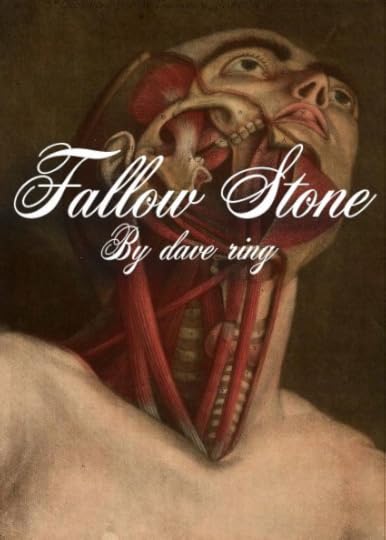
Fallow Stone by dave ring is another queer retelling of Bluebeard, available from Pyre Magazine. This one features a Bluebeard figure (Cyan) who hunts young men to be his “wives”, and it’s told from the perspective of Cyan’s banished daughter/groundskeeper.
I enjoyed this one as well!

“Bluebeard’s Widow” by Iain Rowan is another tale posted on Corvid Queen and free to read there.
It’s flash fiction – very quick to read, where Bluebeard’s widow is on her second marriage and throwing a feast for her brothers and new husband, all of whom had heard rumours about Bluebeard but not warned her about him. It’s a short, punchy little story with a satisfying pay off.
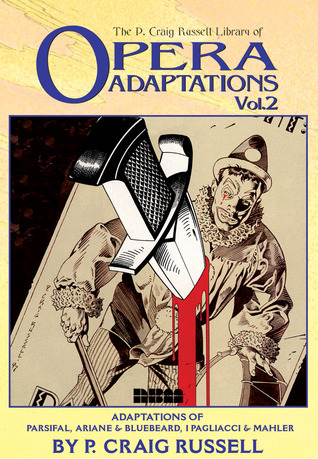
Bluebeard’s Castle is a graphic novel adaptation by P. Craig Russell. It’s the graphic novelisation of the opera, Ariane et Barbe-bleue, by Paul Dukas (his only opera, I believe), which in turn is based upon the symbolist play of the same name by Maurice Maeterlinck. So an adaptation of an adaptation of a retelling!
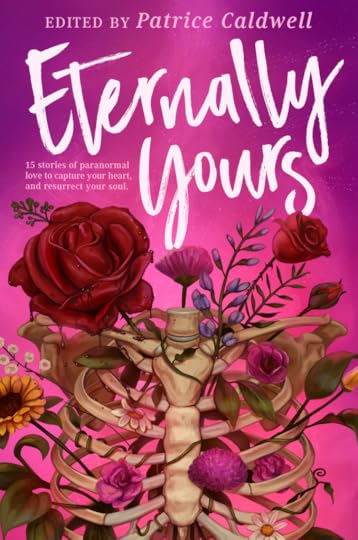
“Bride-Heart” by Marie Rutkoski in the anthology Eternally Yours. This is a queer retelling of Bluebeard set on a flower farm in upstate New York – and there are so many other great authors in this anthology it’s definitely worth picking up, and not just for this story!
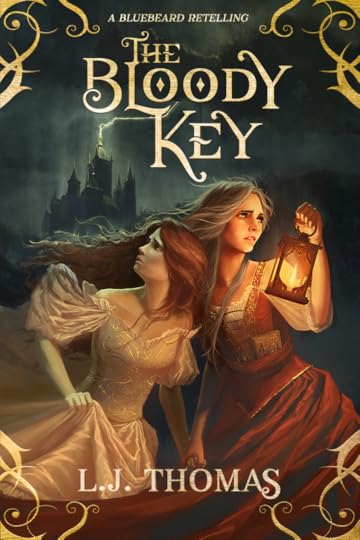
The Bloody Key by L. J. Thomas – an epistolary YA novel from the POV of a 15-year-old goat herder whose older sister marries a mystery nobleman.
Fifteen-year-old Anne tends goats while daydreaming of fairy tales—until the day she finds herself in one. When a wealthy nobleman marries her older sister, they’re both swept off to his castle deep in the woods. Upon entering this world of finery, lush gardens, and nightly balls with dashing suitors, Anne believes her own happily-ever-after is just around the corner. She has almost forgotten the rumors surrounding the estate—tales of the castle’s tragic history and whispers of ghosts—when her sister falls mysteriously ill.
To save her, Anne must uncover the shadowy pasts of those who share her new home. Her sister’s husband refuses to speak of the disappearance of his last wife (or possibly wives), the domineering housekeeper hides her own secrets in a forbidden garden, and the handsome, enigmatic gardener urges Anne to escape the castle and leave her sister behind. There are signs, too, that something dark and supernatural haunts the estate.
If Anne misplaces her trust or fails to discover where the real danger lies, she’ll forfeit her sister’s life—and her own.
Told through the diaries and letters of those who live within the castle, this reimagining of the Bluebeard fairy tale is perfect for fans of Crimson Peak, Erin A. Craig’s House of Salt and Sorrows, Lyndall Clipstone’s Lakesedge or classic Gothic horror.
Next Time:Bluebeard in Film! The next post looks at films with Bluebeard (or Strange Suitor/Robber Bridegroom) type themes. I’ve got a pretty good list of these! You’ll be able to vote for the next tale on that post.
Missed a post? Check below.
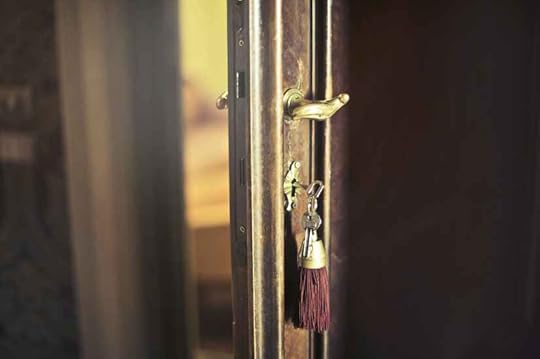 Pexels.com" data-medium-file="https://cmrosens.files.wordpress.com/..." data-large-file="https://cmrosens.files.wordpress.com/..." />The Dangers of Blue Beards (in Books)
Pexels.com" data-medium-file="https://cmrosens.files.wordpress.com/..." data-large-file="https://cmrosens.files.wordpress.com/..." />The Dangers of Blue Beards (in Books)Bluebeard Retellings and Reimaginings As I’m sure you all know I’m not a folklorist or anything like that, but I LOVE folktales and stories, and I think in worldbuilding one of the best and most fun ways to get to grips with a culture is by imagining what stories people tell about themselves and their…… Read more
Jan 16, 2024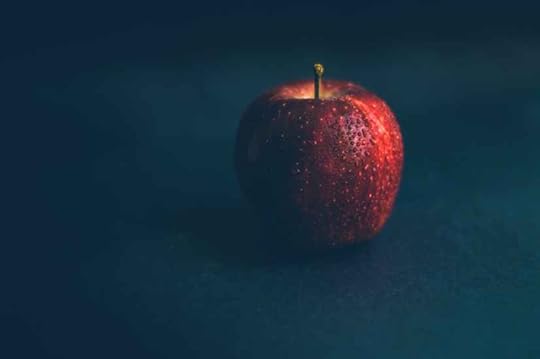 Pexels.com" data-medium-file="https://cmrosens.files.wordpress.com/..." data-large-file="https://cmrosens.files.wordpress.com/..." />A Darker Side of Snow in Cinema
Pexels.com" data-medium-file="https://cmrosens.files.wordpress.com/..." data-large-file="https://cmrosens.files.wordpress.com/..." />A Darker Side of Snow in CinemaHorror Films with Snow White Themes Here is the first post – A Darker Side of Snow in Print – for you to check out as well. In that post I set out my parametres for the tale and specified the type (Aarne/Thompson/Uther Type 709) so you can see what themes I’m including. This time,…… Read more
Jan 12, 2024 Pexels.com" data-medium-file="https://cmrosens.files.wordpress.com/..." data-large-file="https://cmrosens.files.wordpress.com/..." />A Darker Side of Snow in Print
Pexels.com" data-medium-file="https://cmrosens.files.wordpress.com/..." data-large-file="https://cmrosens.files.wordpress.com/..." />A Darker Side of Snow in PrintSnow White Retellings and Reimaginings The tale that won the poll was ‘Snow White’, so I’ve decided to do this one in two posts. The first, here, will look at (1) variations on this tale, and ways to retell it, and (2) your recs for retellings/reimaginings. Please be aware that this post gets dark, so…… Read more
Jan 10, 2024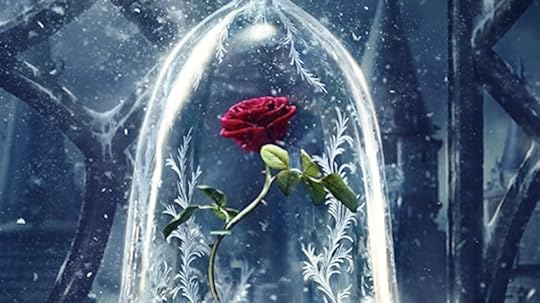 ‘Beauty and the Beast’ in Gothic/Horror Stories
‘Beauty and the Beast’ in Gothic/Horror StoriesBreaking Down the Tale & Book Recommendations This is my first post of 2024, and the final BATB post! Let’s look at how this story can be Gothic, Horror, Dark Romance… and then some examples of this in books in these genres. The elements of the tale lend themselves especially to Gothic tropes, so let’s…… Read more
Jan 3, 2024 Pexels.com" data-medium-file="https://cmrosens.files.wordpress.com/..." data-large-file="https://cmrosens.files.wordpress.com/..." />2023 Wrap-Up
Pexels.com" data-medium-file="https://cmrosens.files.wordpress.com/..." data-large-file="https://cmrosens.files.wordpress.com/..." />2023 Wrap-UpLooking back on the year that was, and looking forward to the year that might be Greetings all, and happy new year! This is my 2023 wrap-up post, many thanks to all who have supported me and made this the most successful sales year to date. My top viewed post this year was my just-for-fun…… Read more
Dec 31, 2023 Beauty and the Beast in Horror Films
Beauty and the Beast in Horror FilmsGreetings! Before I get into the main post, just a note on my newsletter/posts going forward. Since I generally cross-post from my newsletter to my blog, and now that WordPress has a function that enables only subscribers to access certain posts, I’m going to start using that feature for my newsletter. I already didn’t like…… Read more
Dec 29, 2023123…76Next Page→January 12, 2024
A Darker Side of Snow in Cinema
Here is the first post – A Darker Side of Snow in Print – for you to check out as well. In that post I set out my parametres for the tale and specified the type (Aarne/Thompson/Uther Type 709) so you can see what themes I’m including.
This time, it’s films… and… ok, go with me on this one. I asked for some recs and got some really interesting suggestions, plus ones I’m willing to argue myself… but not a hill I’m willing to die on, or anything. Feel free to add more or discuss in the comments.
These films have the theme of a jealous/rage-filled antagonist going after the protagonist, who has some inherent attribute that set them off, or the fact of their existence was enough. Bonus points for themes of reflections/mirrors, even if metaphorical.
Horror Films with Snow White Themes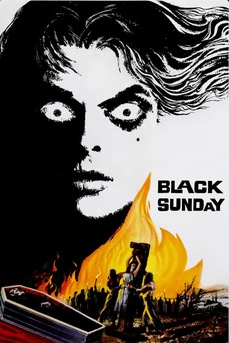
‘La maschera del demonio’/Black Sunday (1960) dir. Mario Bava – A vengeful witch and her fiendish servant return from the grave and begin a bloody campaign to possess the body of the witch’s beautiful look-alike descendant. Only the girl’s brother and a handsome doctor stand in her way.
I’m going to say this one is definitely a Snow White themed film! A handsome doctor, you say…
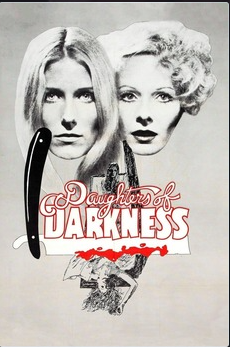
Les lèvres rouges / Daughters of Darkness (1971) dir. Harry Kümel – THESE ARE THE DAUGHTERS OF DARKNESS… THEY ARE WAITING FOR YOU – THEY THRIVE ON BLOOD. A newlywed couple are passing through a vacation resort. Their paths cross with a mysterious, strikingly beautiful countess and her aide.
Yes, it’s vampire lesbians! The wicked queen (Countess) is a vampire, because of course she is, and this was a suggestion as a film with Snow White themes of jealousy and that central conflict between female characters.
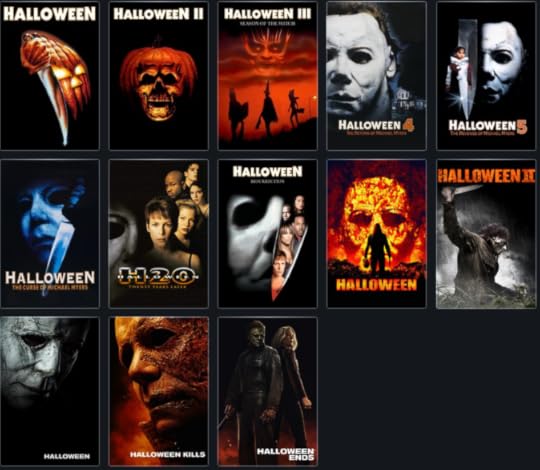
Halloween franchise – ignoring Halloween III, which is not a Michael Myers film. The franchise obviously has various release dates and directors, but the first film, Halloween, was released in 1978 dir. John Carpenter. The most recent film is the conclusion to the reboot trilogy, Halloween Ends (2022), dir. David Gordon Green.
Michael Myers is obsessed with ending his sister Laurie, and she keeps escaping his clutches – often with help from others. There’s also the plot featuring Jamie Lloyd and Michael’s child, in Halloween: The Curse of Michael Myers (1995) dir. Joe Chapelle.
I’d argue that this fits the themes because Michael is the supernatural wicked queen figure, homicidally single-minded and tracking down Laurie (the Snow White figure) wherever she goes, wherever she tries to hide from him. He tries to end her life multiple times through each film and the whole franchise, building up slowly to their final confrontation, but also he is the mirror, the distorted, unkillable reflection of small town evil and ugliness that nobody can control, forcing confrontations they cannot deny.
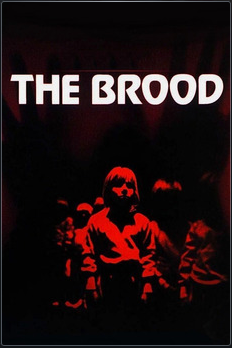
The Brood (1979) dir. David Cronenberg – A man tries to uncover an unconventional psychologist’s therapy techniques on his institutionalized wife, while a series of brutal attacks committed by a brood of mutant children coincides with the husband’s investigation.
I know this one is about as left field as Halloween, but hear me out. Escaping her mother (the wicked queen figure) through marriage (to her Prince), a woman (the Snow White figure) takes her revenge on those who have hurt and abused her by spawning rage-minions (Snow’s helpers/the 7 dwarfs of the fairytale) that go out and commit unspeakable crimes she cannot commit herself. A happy never after.
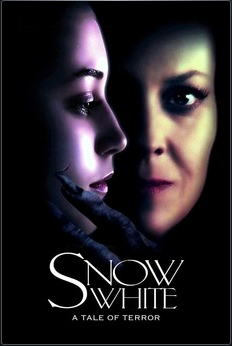
Snow White: A Tale of Terror (1997) dir. Michael Cohn – THE FAIRY TALE IS OVER. When young Lili’s mother dies in childbirth, her father remarries Lady Claudia, a woman ruled by an evil mirror with the power to make her queen of all living things. After escaping an attempt on her life, Lili finds herself lost in a dark forest, where living happily ever after seems unlikely.
This is the horror version of Snow White, and it also deals with miscarriage/stillbirth, and infertility grief. It’s pretty grim, no pun intended.
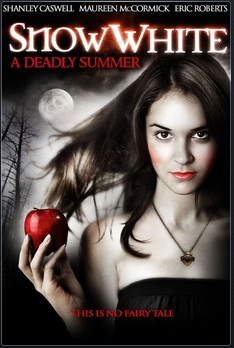
Snow White: A Deadly Summer (2012) dir. David DeCoteau – THIS IS NO FAIRY TALE. A troubled teenage girl finds herself in a web of lies and deceit when her stepmother attempts to murder her by sending her to a discipline camp.
2012 was the year of Snow White: in that year there was fantasy-action Snow White and the Huntsman,Tarsem Singh’s Mirror, Mirror, Spanish version Blancanieves set in 1920s Seville, with Snow as a female bullfighter, which is a black and white silent movie dir. Pablo Berger, Rachel Lee Goldenberg’s Grimm’s Snow White, and the TV series Once Upon A Time was made available outside the USA that year also (it aired on ABC in the US in November 2011). There was also this film.
Snow White keeps the fairytale name (it’s set in the USA so that’s plausible to me as an outsider, US people do name their kids weird things) and goes to a discipline camp with 7 other kids, and then it turns into a slasher. Apparently with no blood or gore, so more like a Goosebumps sort of slasher? I’m pretty sure R. L. Stine did something like this. Anyway, here it is, the “slasher” Snow White, rated… PG13.
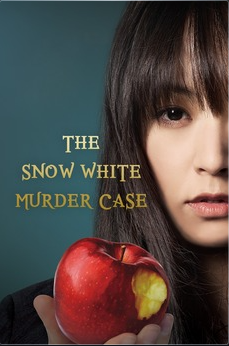
白ゆき姫殺人事件 / The Snow White Murder Case (2014) dir. Yoshihiro Nakamura – Beautiful Noriko Miki works at a cosmetic company. One day, Noriko is murdered. People begin to suspect her co-worker Miki Shirono might have killed her. Television begins to cover her story. A TV show interviews Miki Shirono’s colleagues, family, people from her hometown. Rumors turn into fear. Is she a wicked a woman?
I’ve not seen this one but there are deliberate parallels made in the poster and the title, so I’m going to go with it. It’s more crime thriller than horror, but I think it counts as a dark Snow White film.
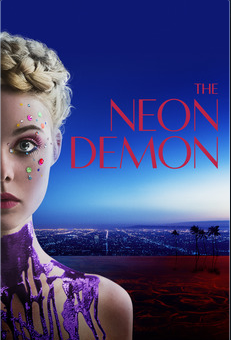
The Neon Demon (2016) dir. Nicolas Winding Refn: BEAUTY IS VICIOUS. When aspiring model Jesse moves to Los Angeles, her youth and vitality are devoured by a group of beauty-obsessed women who will take any means necessary to get what she has.
This one sounds very Snow White in that respect, so maybe it counts!
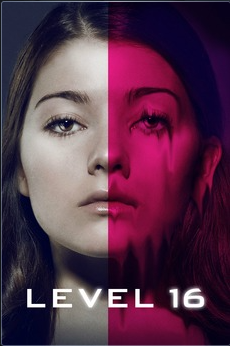
Level 16 (2018) dir. Danishka Esterhazy – PURITY HAS A PRICE. The teenage girls of Vestalis Academy are meticulously trained in the art of being “clean girls,” practicing the virtues of perfect femininity. But what exactly are they being trained for? Vivien intends to find out.
This one was recommended as a Snow White themed film: I think using the idiom ‘snow white’ to mean ‘pure’ or ‘[morally/spiritually] clean’ is a good shout. What do you think, if you’ve seen it?
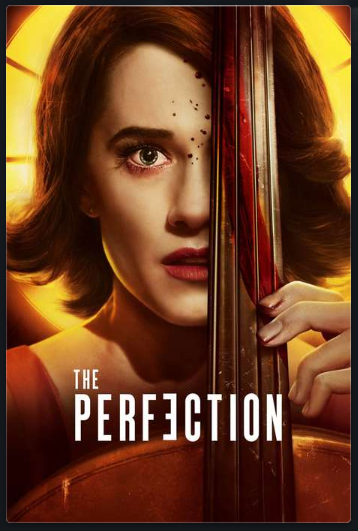
The Perfection (2018) dir. Richard Shepard – IT’S TIME TO FACE THE MUSIC. When troubled musical prodigy Charlotte seeks out Elizabeth, the new star pupil of her former school, the encounter sends both musicians down a sinister path with shocking consequences.
I’ve not seen this one either as I think this might be above the limit of things I’m alright with (but I could just about watch Y Gwledd/The Feast so is it… worse?). This was another recommendation on a film that might have some jealousy/obsession motivation themes underneath. I’m putting it on the list to see if anyone else sees it. There’s definitely some… food stuff… that happens? Is that a poisoned apple equivalent? I don’t know. Discuss.
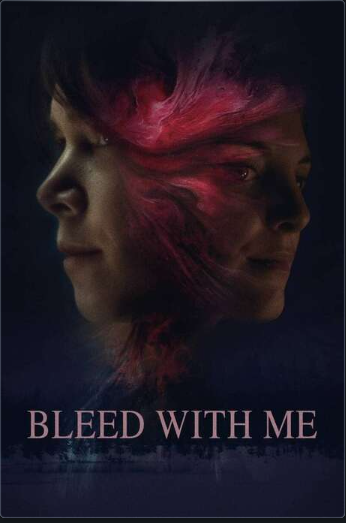
Bleed With Me (2020) dir. Amelia Moses – During a winter getaway at an isolated cabin, a self-destructive young woman becomes convinced that her best friend is stealing her blood.
Amelia Moses also directed Bloodthirsty (2020), a pretty good werewolf film. This one I haven’t seen and was a rec when I asked for films with ‘Snow White’ themes. I can see the vibes in the synopsis, so if anyone else has seen this, would you agree?
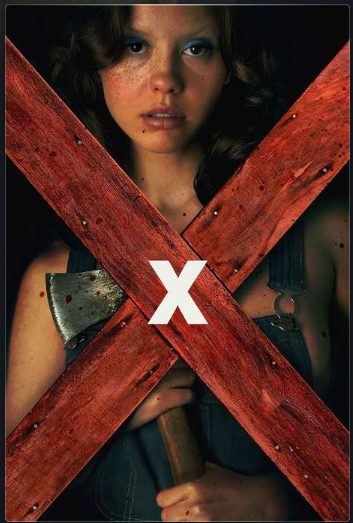
X (2022) dir. Ti West – DYING TO SHOW YOU A GOOD TIME. In 1979, a group of young filmmakers set out to make an adult film in rural Texas, but when their reclusive, elderly hosts catch them in the act, the cast find themselves fighting for their lives.
Forced to confront her own ageing and loss of youth by a vibrant young porn star who looks just like she did when she was younger, Pearl is the wicked queen on a rampage in her tiny gator-infested kingdom, and her loyal husband is her Huntsman (with a weak heart).
This is absolutely a Snow White story, and I doubly love that Mia Goth plays both Pearl and Maxine Minx, so that Pearl (literally) sees her double in Max, along with her lost youth and beauty and sex appeal. This is Pearl’s motivation for her killing spree, aided by her loyal husband who would do anything to make her happy.
Throwing this in at the end as I think it’s the perfect horror film to end on for this post, and such a good film anyway. I loved it and would recommend.
Other Snow White FilmsHere’s a list of some Snow White films – not all are dark!
Snow White and the Seven Dwarfs (1937) dir. David Hand – Disney animation, probably inspired by the [live action silent film] Snow White (1916) dir. J. Searle Dawley.
Grimms Märchen von lüsternen Pärchen / Grimm’s Fairytales for Adults (1969) dir. Rolf Thiele – the erotic versions of some fairy tales including Snow White (with Marie Liljedahl). Definitely not the only Snow White erotica out there. Who can forget that classic animation, Snow White and the Seven Perverts (1973) dir. David Hamilton-Grant? Nobody who saw it, I’ll bet.
白雪姫 / Snow White (1987) dir. Shuichi Ishii – anime adaptation
Good King Wenceslas (1994) dir. Michael Tuchner – gender flipped and based on the story of the real King Wenceslas, the Bohemian king upon whom the Christmas carol is based. This film has the same themes and rough narrative structure as Snow White, if I’m remembering correctly, and I remember noticing this at the time! Wenceslas fights to restore his kingdom from the wicked queen, his tyrannical stepmother, who tries to kill him to prevent him taking the throne. [Other versions of his life include Svatý Václav/St Wenceslas (1930) dir. Jan S. Kolár, a lavish historical drama, and the animated Good King Wenceslas (1996) dir. Keith Scoble.]
Branca de Neve / Snow White (2000) dir. João César Monteiro
Snow White (2001) dir. Caroline Thompson – (Miranda Richardson! And much darker than I expected for kids, but that’s also what I appreciate about it… I was a bit old for it maybe when it came out but would have been entranced as a younger kid, and I do kind of like it now)
Snow White (2005) dir. Samir – contemporary retelling where ‘Prince Charming’ is a rapper, because of course!
Το Σύνδρομο Της Χιονάτης’ / The Snow White Syndrome (2008) dir. Angelos Spartalis
Blanche Neige / Snow White (2010) dir. Angelin Preljocaj – the filmed version of the ballet
Grimm’s Snow White (2012) dir. Rachel Lee Goldenberg
Snow White and the Huntsman (2012) dir. Rupert Sanders
Mirror, Mirror (2012) dir. Tarsem Singh
Blancanieves (2012) dir. Pablo Berger
‘Snjeguljica’ / Snow White (2022) dir. Lana Barić
January 10, 2024
A Darker Side of Snow in Print
The tale that won the poll was ‘Snow White’, so I’ve decided to do this one in two posts. The first, here, will look at (1) variations on this tale, and ways to retell it, and (2) your recs for retellings/reimaginings.
Please be aware that this post gets dark, so either skip to the recs section (but even there, be careful), or stop reading here.
For variations of the Aarne/Thompson/Uther Type 709, here’s a list, trans. and/or ed. by D. L. Ashliman. I’m going to be looking specifically at this type for this post!! There are loads of variations and different cultures have their own, so I wanted to narrow this down. Also, this is the type I grew up with and the only one I feel comfortable claiming.
Snow White: Variations, Interpretations and ReimaginingsThis tale isn’t especially romantic, but there are a plethora of romance, erotica, romantic suspense, and action retellings with romantic subplots, which seek to build a relationship between the protagonist and the “love’s first kiss” giver at the end of the story.
However, because the prince shows up right at the end as a kind of Deus Ex Machina to kiss an apparent (but not actual) corpse in the wood and suddenly restore order and harmony, and the action is focused on the jealous machinations of the mother-figure who wants her daughter-figure dead, a lot of very dark interpretations have sprang up as well. In fact, with the focus off the prince and on the mother/daughter conflict, it quickly slides more firmly into the domestic/family horror arena.
This is the kind of tale that might be used to explore personal feelings around maternal complicity and even jealousy and victim-blaming regarding abuse, or taking the father out of the picture, look specifically at mother-child trauma and abusive/toxic/deeply thorny and complicated relationships in this vein.
Angela Carter, for example, merged this tale with ‘The Snow Child’ and made the mother’s homicidal jealousy revolve around the shifting sexual attraction of her husband (from her to the young girl), implicit in the ending which involves necrophilia.
I’ve provided some context and warnings below, as a lot of the retellings follow Angela Carter’s interpretation of sexual violence and molestation, particularly in collections like Snow White, Blood Red, eds. Datlow and Windling. With this in mind, please be warned that some of the recs below include trigger warnings for rape, while others have warnings for racism, cultural appropriation and transphobia, which I’ve included. In some cases I’ve linked to reviews and articles on the criticism, rather than to the books themselves, which are all easy to find.
For (usually) lighter, more YA-focused, fantasy-heavy versions, try this list of Snow White retellings list on GoodReads. Some other retellings lists are here (kmshea.com has a lot of retelling rec posts so if you’re enjoying these, please check out that site too!). Tor has a list of 7 retellings to check out as well, including the film adaptation Snow White: A Tale of Terror, which I’ll be looking at in my post on Snow White in horror films (next).
Variations & Ideas for RetellingsIf you’re thinking about how to retell the tale in a way that doesn’t have the “snow white skin” element, a lot of variations don’t have it and she’s called something else.
One of the first ‘Snow White’ tales to be written in a ‘literary’ way was by Giambattista Basile in his 1634 work, the Pentamerone, and there she was called Lisa.
In other cultures where a version of this story exists – although with different elements to it – the heroine is variously called Gold Tree (Scotland), Toute-Belle (Brittany), the nameless daughter of jealous Bella Venezia (Italy), Maria in ‘Maria, the Wicked Stepmother, and the Seven Robbers’ (Italy), Ermellina in ‘The Crystal Casket’ (Italy), Myrsina (Greece), and Nourie Hadig (Armenia).
So it’s perfectly fine to skip the “I wish I had a daughter with these 3 attributes” part and get right to the story, as this isn’t in all the versions of the tales, or you could swap out the 3 physical things Snow White’s mother wishes for with 3 other things to keep the rhythm and the feel of a fairytale. The only important thing is that the tale is essentially about an antagonist who is having an existential crisis – in this case, about aging, losing her looks (and therefore her value in her society, and her self-worth along with it) and becoming homicidally jealous of her own daughter, who is growing into her looks as fast as the mother is growing out of them. (Or stepmother, or guardian of some kind!)
This doesn’t even have to be about physical beauty, either. It could be just the fact her daughter has her youth, and the mother wants her own back for whatever reason. (No need to make this ableist, though…)
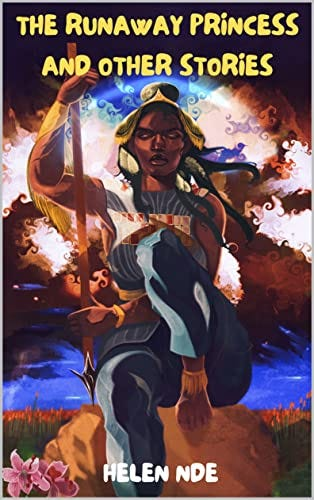
If you gender flip this, it still works for appearance/aesthetic playing into fears of ageing. You could look at the struggle between a father and son, replacing “beauty” with another attribute that has social currency. For example, usurpation of social position and the power that comes with it can be applied to any genders within a tale like this that is older gen vs younger gen.
The Mwindo Epic is obviously not from the Aarne/Thompson/Uther type, BUT it sprang to mind when I thought about the genderflip thing, and it’s fresh in my mind as it was mentioned by Helen Nde, curator of the Mythological Africans project and author of The Runaway Princess and Other Stories, in her interview on Eldritch Girl podcast (2023). If you haven’t heard Helen’s talks, a lot are available to watch/listen to, and the Mythological Africans podcast is great!
I also thought about how in Greek myth, King Laius vs Oedipus his son could be another narrative that plays with these themes, with Queen Jocasta as the poisoned apple in this scenario…
My husband’s idea for this is a gender-flipped historical fiction version set in 19thC Europe, where you contemporaneously have people comparing a man’s bravery and a woman’s beauty, which would mean concepts of bravery and cowardice in this time period are the ‘masculine’ version of the maternal ‘beauty’ crisis.
You can worldbuild around this construct and have ‘bravery’ as social currency, rather than (or as well as) evidence of good character, which would lead to all sorts of interesting things regarding societal context.
A son/father relationship where the father fears he is becoming a coward in his old age, while the son is out fighting Napoleon (or fighting FOR Napoleon, if so inclined), and so you have the father engineering behind-the-scenes career sabotage.
(Why yes, he is a big reader of Patrick O’Brian books, how did you guess??)
I would add in : as the son looks set to climb higher in the ranks than the father did (bringing in a whole host of social mores and hierarchical issues to explore). I think this might work especially well if the son was illegitimate, for example, (or stepson would work also depending on the social status of his late parents) and their relationship was only good when the son had to depend on his father’s paternalistic benevolence – so in upending that, and changing the power dynamic, the relationship fractures completely. (What’s the poisoned apple in this version?)
If you don’t like the hist fic angle here, you can transpose it as you please (including to a SciFi/second world fantasy world or setting) and make this work for any gender and attribute! Developing this existential crisis within a societal framework and exploring all the many factors that precipitate it and the antagonist’s courses of action may help to alleviate the flatness of the tale where the antagonist is reduced to a single motivator (jealousy) and creates more interlocking, intersecting factors to enrich the story.
There are a ton of things to choose from and reimagine, so there are a lot of ways this tale can be reinvented. Here are some ways it has been! I wouldn’t have known where to start to be honest, so this is the list of things people said when asked what versions they could think of/which were their favourites. I got a very mixed bag here, which made things interesting!
Retellings/Reimaginings You Told Me AboutI am asking for recs and starting conversations around these stories, because there are SO MANY of them that I wouldn’t have a clue where to start. Also, in recommending and discussing them, I get to hear about stories I may otherwise never have come across, and get to share them. Here are the stories that came up this time.
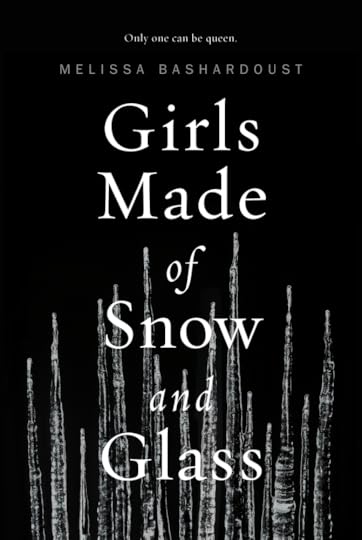
Girls Made of Snow and Glass by Melissa Bashardoust
Frozen meets The Bloody Chamber in this feminist fantasy reimagining of the Snow White fairytale.
Sixteen-year-old Mina is motherless, her magician father is vicious, and her silent heart has never beat with love for anyone—has never beat at all, in fact, but she’d always thought that fact normal. She never guessed that her father cut out her heart and replaced it with one of glass. When she moves to Whitespring Castle and sees its king for the first time, Mina forms a plan: win the king’s heart with her beauty, become queen, and finally know love. The only catch is that she’ll have to become a stepmother.
Fifteen-year-old Lynet looks just like her late mother, and one day she discovers why: a magician created her out of snow in the dead queen’s image, at her father’s order. But despite being the dead queen made flesh, Lynet would rather be like her fierce and regal stepmother, Mina. She gets her wish when her father makes Lynet queen of the southern territories, displacing Mina. Now Mina is starting to look at Lynet with something like hatred, and Lynet must decide what to do—and who to be—to win back the only mother she’s ever known…or else defeat her once and for all.
Entwining the stories of both Lynet and Mina in the past and present, Girls Made of Snow and Glass traces the relationship of two young women doomed to be rivals from the start. Only one can win all, while the other must lose everything—unless both can find a way to reshape themselves and their story.
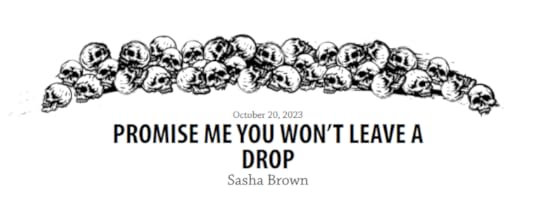
Promise Me You Won’t Leave A Drop (horror flash fic, voring) by Sasha Brown
Deliciously creepy short fiction free to read via the hyperlinked title.
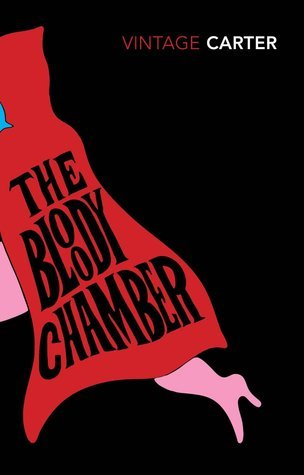
“The Snow Child” (TW: necrophilia/paedophilia) by Angela Carter, available at the link and in the collection The Bloody Chamber and Other Stories.
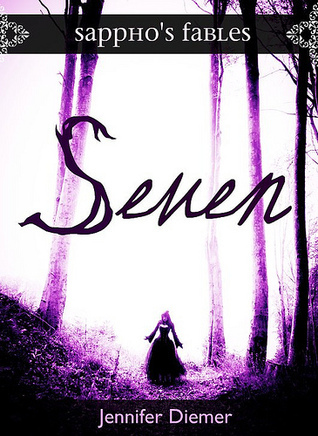
Seven by Jennifer Diemer
The strange witch girl Neve has skin as white as snow, lips as red as blood, and a dark secret. Her father Lexander, an alchemist, harbors an evil obsession, and Catalina, his newest bride, made the grave mistake of becoming his wife. When Catalina finds herself falling in love with his daughter, Neve, instead, the deepening bond between the women sets in motion the final chapter of a story that began long ago, with a desperate longing and a handful of apple seeds. Together, Neve and Catalina must venture into the Huntsman’s haunted forest to undo what has been done and set themselves free.
The novella SEVEN is the lesbian retelling of the classic fairy tale, “Snow White.” It is part of the series SAPPHO’S FABLES: LESBIAN FAIRY TALES.
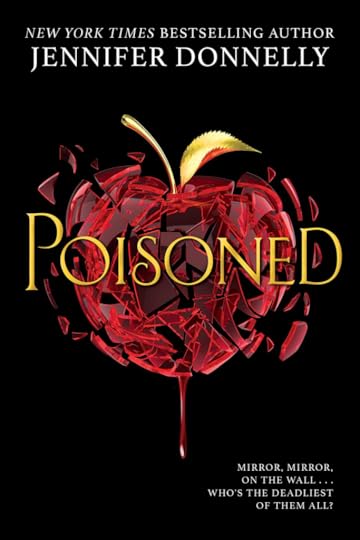
Poisoned by Jennifer Donnelly
Once upon a time, a girl named Sophie rode into the forest with the queen’s huntsman. Her lips were the color of ripe cherries, her skin as soft as new-fallen snow, her hair as dark as midnight. When they stopped to rest, the huntsman pulled out his knife . . . and took Sophie’s heart.
It shouldn’t have come as a surprise. Sophie had heard the rumors, the whispers. They said she was too kind and foolish to rule — a waste of a princess. A disaster of a future queen. And Sophie believed them. She believed everything she’d heard about herself, the poisonous words people use to keep girls like Sophie from becoming too powerful, too strong . . . With the help of seven mysterious strangers, Sophie manages to survive. But when she realizes that the jealous queen might not be to blame, Sophie must find the courage to face an even more terrifying enemy, proving that even the darkest magic can’t extinguish the fire burning inside every girl, and that kindness is the ultimate form of strength.
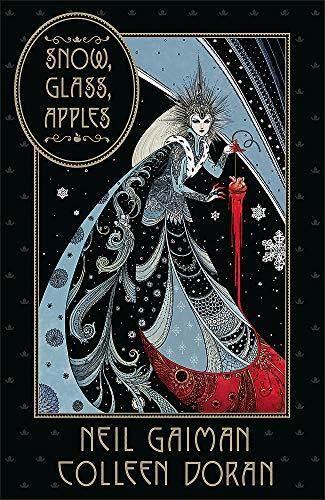
Snow, Glass, Apples, by Neil Gaiman
A chilling fantasy retelling of the Snow White fairy tale by bestselling creators Neil Gaiman (author) and Colleen Doran (adaptor and illustrator).
A not-so-evil queen is terrified of her monstrous stepdaughter and determined to repel this creature and save her kingdom from a world where happy endings aren’t so happily ever after.
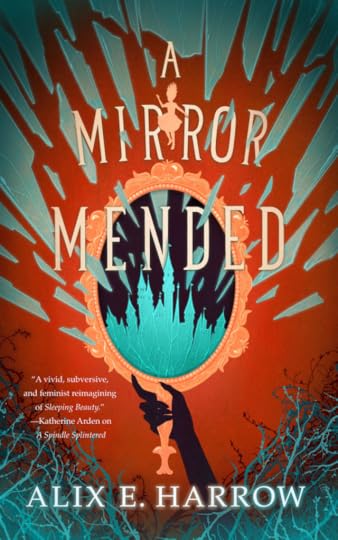
A Mirror Mended by Alix E. Harrow (Book 2 of the Fractured Fables series).
A Mirror Mended is the next installment in USA Today bestselling author Alix E. Harrow’s Fractured Fables series.
Zinnia Gray, professional fairy-tale fixer and lapsed Sleeping Beauty, is over rescuing snoring princesses. Once you’ve rescued a dozen damsels and burned fifty spindles, once you’ve gotten drunk with twenty good fairies and made out with one too many members of the royal family, you start to wish some of these girls would just get a grip and try solving their own narrative issues.
Just when Zinnia’s beginning to think she can’t handle one more princess, she glances into a mirror and sees another face looking back at her: the shockingly gorgeous face of evil, asking for her help. Because there’s more than one person trapped in a story they didn’t choose. Snow White’s Evil Queen has found out how her story ends, and she’s desperate for a better ending. She wants Zinnia to help her before it’s too late for everyone. Will Zinnia accept the Queen’s poisonous request and save them both from the hot-iron shoes that wait for them, or will she try another path?
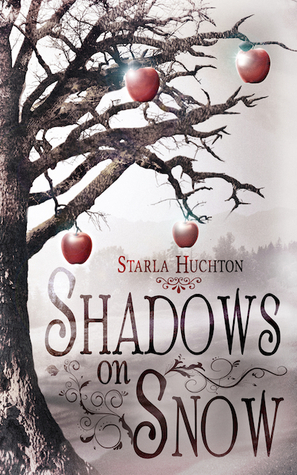
Shadows on Snow by Starla Huchton (gender flipped!)
Once upon a time, a dark evil crept into my kingdom, stealing my loved ones and the happy life I knew. The world turned against me, and I swore to become stronger, to keep myself safe.
Once upon a time, there was a handsome prince, hair dark as ebony, skin as pure as the freshly driven snow, and I became the only one who stood between him and death.
Once upon a time, our stories intertwined, and now, healing my heart may be the only way to save us all from the evil that threatens to destroy what little we have left.
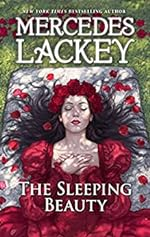
The Sleeping Beauty by Mercedes Lackey (despite the title, this is also a Snow White tale).
Heavy is the head—and the eyelids—of the princess who wears the crown…
In Rosamund’s realm, happiness hinges on a few simple
For every princess there’s a prince.
The king has ultimate power.
Stepmothers should never be trusted.
And bad things come to those who break with Tradition….
But when Rosa is pursued by a murderous huntsman and then captured by dwarves, her beliefs go up in smoke. Determined to escape and save her kingdom from imminent invasion, she agrees to become the guinea pig in one of her stepmother’s risky incantations—thus falling into a deep, deep sleep.
When awakened by a touchy-feely stranger, Rosa must choose between Tradition and her future…between a host of eligible princes and a handsome, fair-haired outsider. And learn the difference between being a princess and ruling as a queen.
The moral of the story? Sometimes a princess has to create her own happy endings….
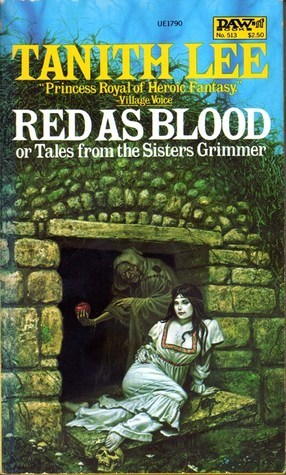
“Red as Blood” by Tanith Lee, in Red as Blood or Tales from the Sisters Grimmer.
How would it be if Snow White were the real villain & the wicked queen just a sadly maligned innocent? What if awakening the Sleeping Beauty should be the mistake of a lifetime–of several lifetimes? What if the famous folk tales were retold with an eye to more horrific possibilities?
Only Tanith Lee could do justice to it. In RED AS BLOOD, she displays her soaring imagination at its most fantastically mischievous. Not for nothing was the title story named as a Nebula nominee. Not for nothing was the author of THE BIRTHGRAVE & THE STORM LORD called by New York’s Village Voice, “Goddess-Empress of the Hot Read.”
Here are the world-famous tales of such as the Brothers Grimm as they might have been retold by the Sisters Grimmer! Fairy tales for children? Not on your life!
Contents:
Paid Piper (1981)
Red as Blood (1979)
Thorns (1972)
When the Clock Strikes (1980)
The Golden Rope (1983)
The Princess and Her Future (1983)
Wolfland (1980)
Black as Ink (1983)
Beauty (1983)
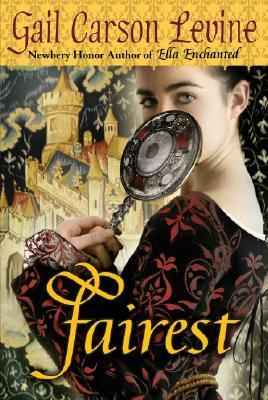
Fairest by Gail Carson Levine
In the kingdom of Ayortha, who is the fairest of them all? Certainly not Aza. She is thoroughly convinced that she is ugly. What she may lack in looks, though, she makes up for with a kind heart, and with something no one else has-a magical voice. Her vocal talents captivate all who hear them, and in Ontio Castle they attract the attention of a handsome prince – and a dangerous new queen.
In this masterful novel filled with humour, adventure, romance, and song, Newbery Honor author Gail Carson Levine invites you to join Aza as she discovers how exquisite she truly is.
Ages 8 – 14
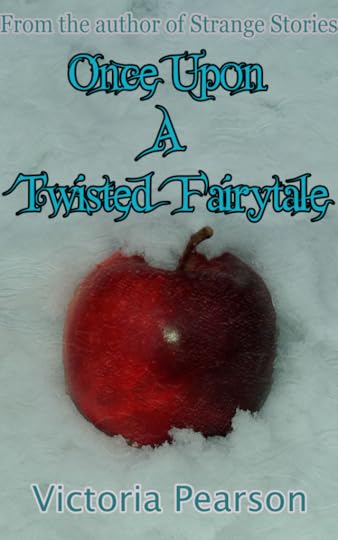
‘The Missold Prince’ in Once Upon A Twisted Fairytale collection by Victoria Pearson
From the author of the Strange Stories series and A Tale of Two Princes comes Once Upon A Twisted Fairytale; ten classic fairytale re-tellings for grown-ups, twisted as only Victoria Pearson can.
What if Red Riding Hood’s Grandmother didn’t want to be saved? What if Cinderella’s prince was actually a bit of a creep? What exactly was Prince Charming doing kissing a girl he found in a coffin anyway? Find out why you should always be careful what you wish for, why you shouldn’t trust Hansel and Gretel just because they look sweet, and why you really don’t want to displease Mr Elffe.
Grab some iron to protect you from the shining ones, some salt to throw in the face of the fairies, and see what happened once upon a twisted fairytale…
Some of these stories have appeared in some form in other short story collections by Victoria Pearson.
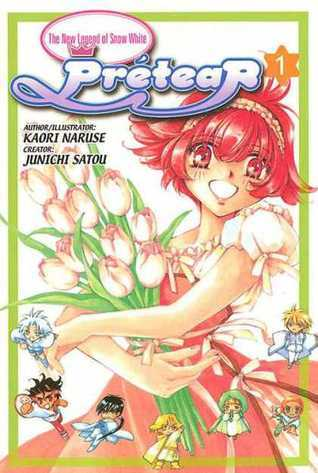
Prétear (manga by Junichi Satō and Kaori Naruse)
Himeno is a high school freshman who’s having trouble adjusting to the lifestyle of the very rich. Her father, Kaoru, is a one-time famous author of young girls’ novels. One of his greatest fans was Natsue, a wealthy woman who liked Kaoru so much that she snatched him up from their rundown apartment and married him.
But Himeno’s life is far from rosy. Her dad tends to take the side of Natsue rather than her, and Natsue’s two daughters from a previous marriage aren’t very fond of their new stepsister. One day, Himeno takes a shortcut to school and meets a young boy. When she takes the boy’s hand, she’s transported to a fantasy world that lies on the brink of extinction. And the one person that can stop it is the girl called “Prétear.”
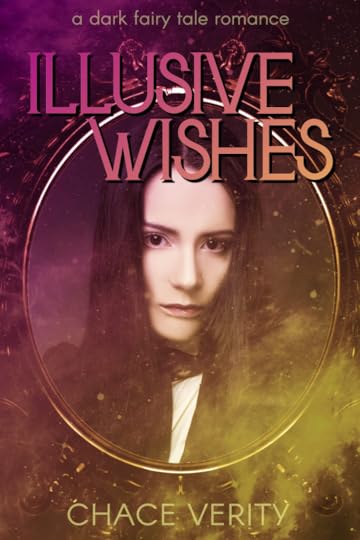
Illusive Wishes by Chace Verity (Standalone Book 2 in the Dithered Hearts series)
Ever since becoming disowned by his family, the person who matters most to Isaac is his best friend. Unfortunately, said best friend is trapped inside a mirror. For two years, Isaac has traveled various kingdoms with Penn at his side, searching for clues to break the curse and earning money however he can. When offered a job as an escort for a lavish party at the Embedded Palace—a place teeming with wealth and potential magic—Isaac is quick to accept. For the friend he’s fallen in love with, he’ll do anything.
Being stuck in a mirror is one thing, but for Penn, it’s even more humiliating because they’re a fairy who should have been able to avoid the curse. Whatever the curse is. They can’t quite remember. If only they had been a storybook Prince Charming instead of a useless fairy, life would have been better. But with a sweet, kind, and alluring friend like Isaac helping them, they refuse to give up.
As soon as the pair arrive at the Embedded Palace, buried memories start surfacing, darker than either of them ever imagined. With a misanthropic knight who has ties to fairies, cursed apples, a queen seeking an enchanted mirror, and a hunter obsessed with Isaac, the inseparable best friends find themselves being pulled apart. Maybe not even a Prince Charming can save the day, but Penn and Isaac will do anything to make their deepest wish come true—to be with each other.
Illusive Wishes is a full-length, standalone novel in the Dithered Hearts series.
NotesThe Serpent’s Shadow by Mercedes Lackey features a mixed race British-Indian heroine called Maya. The review/description on GoodReads is reproduced below and also available here.
Mercedes Lackey returns to form in The Serpent’s Shadow, the fourth in her sequence of reimagined fairy tales. This story takes place in the London of 1909, and is based on “Snow White and the Seven Dwarfs.” Lackey creates echoes of Sir Arthur Conan Doyle, pays affectionate homage to Dorothy Sayers’s Lord Peter Wimsey (who plays an important role under a thin disguise), and turns the dwarves into seven animal avatars who masquerade as pets of her Eurasian heroine, Maya.
Some of Maya’s challenges come from the fact that she is not “snow white,” and she has fled India for her father’s English homeland after the suspicious deaths of her parents. Establishing her household in London, she returns to her profession as a physician, working among the poor. Her “pets” and loyal servants stand guard, and Maya herself uses what bits of magic she managed to pick up in childhood to weave otherworldly defenses as well. But the implacable enemy who killed her parents has come to London to search for her; if Maya can be enslaved, her enormous potential powers can be used to the enemy’s ends. Fortunately, English magicians of the White Lodge have also noted a new, powerful presence in their midst, though they’re having trouble locating her, too. They send Peter Scott, a Water Master, to track her down. He finds Maya beautiful and benign, and is determined to teach her to use the Western magic she is heir to, before her enemy discovers her.
Some will find the author’s Kiplingesque descriptions of India and Hindustani culture offensive. Lackey describes Maya’s enemy as a powerful devotee of the goddess Kali-Durga, though she carefully shows that the avatars of the other deities will not attack her, and has Kali-Durga repudiate her servant in the climactic confrontation. And, though the story is layered, its surface is as glossy and brightly colored as an action comic. But readers who enjoy late Victorian London, Sayers, Sherlock Holmes stories, and a page-turning tale will want to take this one home. –Nona Vero
Boy, Snow, Bird by Helen Oyeyemi has been criticised for its harmful trans analogy/narrative, and is discussed in detail alongside a positive depiction of trans masc identity in G. D. Vidrine’s A Pair of Raven Wings, (a queer and trans retelling of ‘The Seven Ravens’ fable) in this open access article by Jeana Jorgensen, A Tale of Two Trans Men: Transmasculine Identity and Trauma in Two Fairy-Tale Retellings, From the journal Open Cultural Studies (https://doi.org/10.1515/culture-2020-0128).
Six-Gun Snow White by Catherynne M. Valente has been criticised for its harmful Native depictions and appropriation. It is strongly not recommended by the AICL (American Indians in Children’s Literature).
Next Time:Snow White themes in Horror Movies! I had fun with this. You’ll be able to vote in the poll for the next tale in that post.
January 3, 2024
‘Beauty and the Beast’ in Gothic/Horror Stories
This is my first post of 2024, and the final BATB post! Let’s look at how this story can be Gothic, Horror, Dark Romance… and then some examples of this in books in these genres.
The elements of the tale lend themselves especially to Gothic tropes, so let’s look at these more closely, and build a new Gothic version from them like a series of writing prompts!
The family suffer a reversal of fortune. Loss of fortune in Gothic novels is usually a very bad sign for the heroine, as it puts her in danger of power imbalance by various villainous figures, but it can also outwardly symbolise the decay of the family’s morals and respectability.For Belle, it’s the former, and for the Beast, it’s the latter, but in your version, there’s no reason why it can’t be the other way around – or that Belle is the monstrous one/from a “monstrous” background. Playing around with this can set the tone if you’re going for horror, and especially if your horror has a Gothic flavour.
The loss of fortune for Belle is an indignity that she can rise above, and in doing so, she foreshadows her ability to transform the Beast’s own decay and monstrosity and restore him to civilised society. Some examples of the rich family come down in the world, or specifically, the impoverished heroine hoping for a rags-to-riches narrative arc, but not necessarily BATB tales, include:
The House of the Seven Gables by Nathaniel Hawthorne Jane Eyre by Charlotte Bronte Dragonwyck by Anya Seton I Capture the Castle by Dodie Smith (Gothic vibes but not horror) The Little Stranger by Sarah WatersThe Monster of Elendhaven by Jennifer Giesbrecht.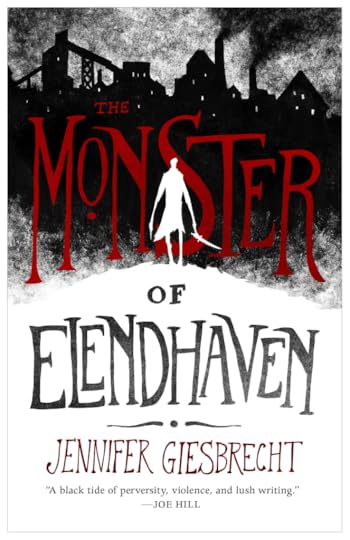 The fatal request. Belle asks her father for a rose, and that leads him to steal from the Beast’s garden and make the fateful deal to become the Beast’s prisoner in exchange, as penalty for his theft. There are then two ways this can go: one, the Beast threatens to kill him (and his family) unless his daughter Belle becomes his prisoner, or two, Belle swaps herself for her father to save him, which is the version that affords her more agency.
The fatal request. Belle asks her father for a rose, and that leads him to steal from the Beast’s garden and make the fateful deal to become the Beast’s prisoner in exchange, as penalty for his theft. There are then two ways this can go: one, the Beast threatens to kill him (and his family) unless his daughter Belle becomes his prisoner, or two, Belle swaps herself for her father to save him, which is the version that affords her more agency. This trope might also be thought of as the protagonist’s mistake, which is the one that leads them into the clutches of the villain of the tale, or the antihero love interest, depending on the story. It could also be thought of as the be careful what you wish for trope.
In The Death of Jane Lawrence by Caitlin Starling, Jane’s marriage of convenience comes with a caveat: not to stay at Lindridge Hall, her husband’s crumbling manor. And of course, she does, and in doing so is swept up in some dark secrets and creepy Gothic, magical goings-on.
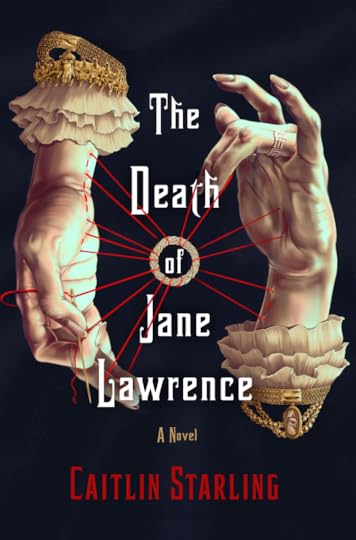
Practical, unassuming Jane Shoringfield has done the calculations, and decided that the most secure path forward is this: a husband, in a marriage of convenience, who will allow her to remain independent and occupied with meaningful work. Her first choice, the dashing but reclusive doctor Augustine Lawrence, agrees to her proposal with only one condition: that she must never visit Lindridge Hall, his crumbling family manor outside of town. Yet on their wedding night, an accident strands her at his door in a pitch-black rainstorm, and she finds him changed. Gone is the bold, courageous surgeon, and in his place is a terrified, paranoid man—one who cannot tell reality from nightmare, and fears Jane is an apparition, come to haunt him.
By morning, Augustine is himself again, but Jane knows something is deeply wrong at Lindridge Hall, and with the man she has so hastily bound her safety to. Set in a dark-mirror version of post-war England, Starling crafts a new kind of gothic horror from the bones of the beloved canon. This Crimson Peak-inspired story assembles, then upends, every expectation set in place by Shirley Jackson and Rebecca, and will leave readers shaken, desperate to begin again as soon as they are finished.
In The Phantom of the Opera by Gaston Leroux, Christine Daae prays for the Angel of Music, which her late father promised he would send her after his death. In fact, what she gets is Erik – and she is easily persuaded that Erik is her angel, because of her late father’s promise. Ask for a rose, get the thorns as well.
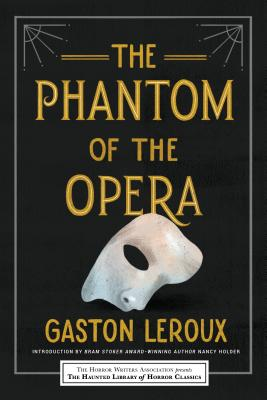 The cursed hero/antihero/antivillain/villain/antagonist in mysterious, Gothic surroundings. This could be the Byronic Hero, the Fallen Hero, the Antihero, the Villain Protagonist… the list goes on. In Dark Romance, this is the serial killer who will kill everyone you know except you, or the villain who wants you for his own twisted reasons. Either way, this is the monster in the castle, and
there must be one
for this to be a Beauty and the Beast story.
Usually
but
not necessarily
, this figure is connected to a creepy house, a castle, the catacombs, somewhere dark and mysterious. Or, if we’re in Southern Gothic territory, maybe the swamps. Australian Gothic would have other settings – the desert, the mangrove swamps, a small isolated town… wherever it is, there’s some monstrous bastard lurking there, and they’re after you. For Reasons.
The cursed hero/antihero/antivillain/villain/antagonist in mysterious, Gothic surroundings. This could be the Byronic Hero, the Fallen Hero, the Antihero, the Villain Protagonist… the list goes on. In Dark Romance, this is the serial killer who will kill everyone you know except you, or the villain who wants you for his own twisted reasons. Either way, this is the monster in the castle, and
there must be one
for this to be a Beauty and the Beast story.
Usually
but
not necessarily
, this figure is connected to a creepy house, a castle, the catacombs, somewhere dark and mysterious. Or, if we’re in Southern Gothic territory, maybe the swamps. Australian Gothic would have other settings – the desert, the mangrove swamps, a small isolated town… wherever it is, there’s some monstrous bastard lurking there, and they’re after you. For Reasons.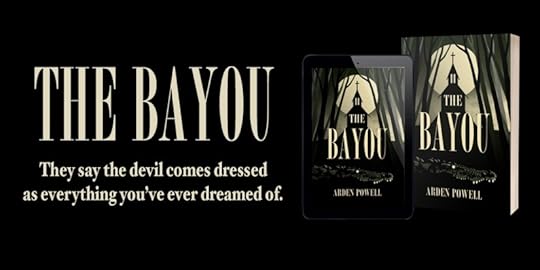
In Arden Powell’s m/m Gothic Horror novella The Bayou, it’s dark fae and the Louisiana swamps that form the BATB background, and Eugene’s twisted relationship with the enigmatic fugitive calling himself Johnny Walker is the central relationship. Eugene is the cursed one (haunted by a past he cannot remember), but Johnny himself has/had ties to the area he cannot escape, either.
The protagonist has to meet a figure embodying monstrosity in some form. They may be physically monstrous (but this can go along with an ableist plot or tropes, especially if this character is human and scarred/disabled/has physical differences, so be careful of that) or they are an actual monster, or the monstrosity is internal – they might be a serial killer, e.g., as in Dark Romance.
This comes up a lot in various forms: Pamela by Samuel Richardson, for example (a Sentimental novel rather than a Gothic one), Jane Eyre by Charlotte Bronte certainly, where its other parallels are discussed here, and Phantom of the Opera by Gaston Leroux.
As I mentioned before in the previous post on horror films, the love triangle where the Beast does not ‘transform’ and therefore loses out to the hero can function as a split between Beast and Prince, with the hero as a foil for the Beast. The protagonist (usually a heroine) must work out their feelings for the Beast or at least come to terms with the fact that the Beast’s monstrosity cannot be ‘saved’ or ‘redeemed’ through the protagonist’s love and actions. Here, the transformation aspect is more the pivoting away from the monstrous and its allure or influence, towards the person the protagonist’s love can affect/effect in a positive way.
Not all Dark Romances are Beauty and the Beast adjacent, but quite a few are. Here’s a GoodReads list of Dark Romance, so you can have a look!
Some that have been recc’d to me as BATB or BATB-adjacent are books by:
A. J. Merlin (Pleasure and Prey series),H. D. Carlton (Cat and Mouse duology),Harley Laroux (Souls Trilogy).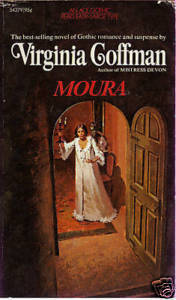
Of course, meeting the beastly man and taming him is a staple trope in Romantic Suspense and pulp Gothic Romance, too – Nine Coaches Waiting by Mary Stewart is an obvious one, and so are Moura and The Devil Beyond Moura by Virginia Coffman (Anne Wicklow series, Books 1 and 4).
Salt & Broom by Sharon Lynn Fisher is a dark SFF retelling of Jane Eyre (respelled as Aire, although other characters retain their original names), which I think counts here as Jane Eyre has so many BATB parallels already.
Similarly, The Wife in the Attic by Rose Lerner is another retelling of Jane Eyre in the sapphic vein, with plenty of atmospheric Gothic flavour.
Jane Slayre by Sherri Browning Erwin is in the same vein as Pride and Prejudice and Zombies, except Jane is battling vampires in this mash-up, and Bertha is a bloodthirsty werewolf in the attic. She’s still head-over-heels for Rochester, though.
Again, I’m going to add I Feed Her To The Beast and the Beast Is Me by Jamison Shea, because this has a ballet dancer becoming a Beast-like figure (it’s explicitly a villain origin story), by giving herself to the eldritch blood river in the Paris catacombs and kissing the poisonous monster boy who has already made several deals with the river himself. This is a very loose and adjacent BATB story, but it’s got so many of the elements and then does very clever and fun things with them, and I think it’s worth a look.
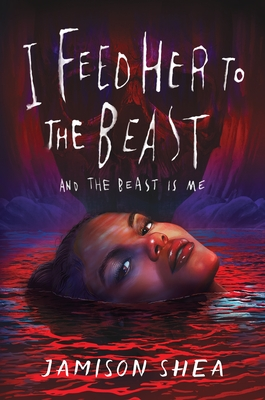 A transformation occurs due to the relationship between Beast and protagonist. The usual nature of this transformation is the returning of the Beast’s humanity, or the transformation of the Beast into a worthy partner for the protagonist. This can be done through breaking a literal curse, or by a shift in the Beast’s perspective and attitudes. However,
the transformation process may be subverted
so that it is the protagonist who changes and becomes more ‘Bestial’, or the transformation/curse breaking part is actually the freeing of the protagonist from the Beast’s influence to choose the Prince figure at the end of the story. The Prince in this case is the foil for the Beast.
A transformation occurs due to the relationship between Beast and protagonist. The usual nature of this transformation is the returning of the Beast’s humanity, or the transformation of the Beast into a worthy partner for the protagonist. This can be done through breaking a literal curse, or by a shift in the Beast’s perspective and attitudes. However,
the transformation process may be subverted
so that it is the protagonist who changes and becomes more ‘Bestial’, or the transformation/curse breaking part is actually the freeing of the protagonist from the Beast’s influence to choose the Prince figure at the end of the story. The Prince in this case is the foil for the Beast.Clive Barker gets a mention for these sorts of storylines. He writes about this… a lot. The Hellbound Heart is an obvious one (and I covered its film adaptation, Hellraiser, in my previous post). There are also BATB themes of transformation in Cabal and Imajica, and plenty more in the short stories collected in the volumes of The Books of Blood.
So does Angela Carter (in very different ways), and there are many stories where female agency is explored through the monstrous feminine, or in the female protagonist’s transformation and gaining of agency.
In fact, I think a lot of Carter’s writing explores themes found in Beauty and the Beast, not just in her collected short stories but in some of her novels as well, like Heroes and Villains (cw for rape).
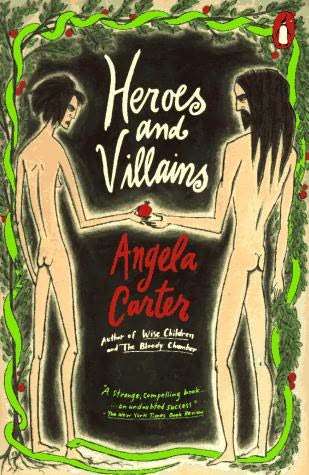
After the apocalypse the world is neatly divided.
Rational civilization rests with the Professors in their steel and concrete villages; marauding tribes of Barbarians roam the surrounding jungles; mutilated Out People inhabit the burnt scars of cities.
But Marianne, a Professor’s daughter, is carried away into the jungle–a grotesque vegetable paradise–where she will become the captive bride of Jewel, the proud and beautiful Barbarian. There she will witness the savage rituals of the snake worshippers, indulge her voluptuous, virginal fantasies, taste the forbidden fruit of chaos…
Erotic, exotic, and bizarre, HEROES AND VILLAINS is a post-apocalyptic romance, a gripping adventure story, a colourful embroidery of religion and magic and, not least, a dispassionate vision of life beyond our brave nuclear world.
Again, the plot doesn’t need to be romantic. Familial relationships with these elements include The Book Eaters by Sunyi Dean, where transformations in attitude and perspective occur for love, in this case, of a mother for her son. Devon’s son is born with his ‘curse’ (not really an actual curse, but an anomalous ability, and a need to eat human minds rather than books).
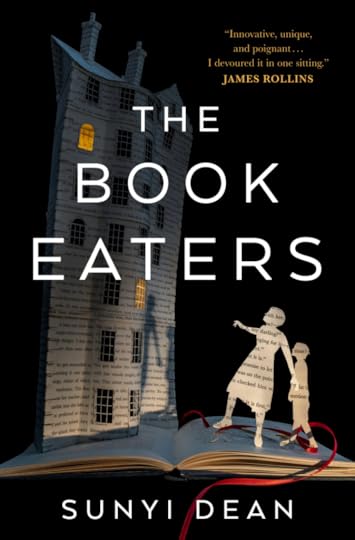
Out on the Yorkshire Moors lives a secret line of people for whom books are food, and who retain all of a book’s content after eating it. To them, spy novels are a peppery snack; romance novels are sweet and delicious. Eating a map can help them remember destinations, and children, when they misbehave, are forced to eat dry, musty pages from dictionaries.
Devon is part of The Family, an old and reclusive clan of book eaters. Her brothers grow up feasting on stories of valor and adventure, and Devon—like all other book eater women—is raised on a carefully curated diet of fairy tales and cautionary stories.
But real life doesn’t always come with happy endings, as Devon learns when her son is born with a rare and darker kind of hunger—not for books, but for human minds.
I think you can see a bit of the subverted transformation and reclamation of the curse, changing it into something else via love and community, in The Gilda Stories by Jewelle Gomez.
Vampire stories often have BATB or BATB-adjacent plots (looking at you, Anne Rice), but if I’m going to mention one of them, I would like it to be this one, as I think this is beautifully done with slice-of-life segments. This one is not intended to be a BATB tale, necessarily, but I think you can see some themes there.
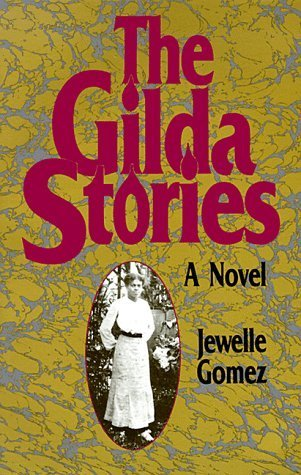
The winner of two Lambda Literary Awards (fiction and science fiction) The Gilda Stories is a very lesbian American odyssey. Escaping from slavery in the 1850s Gilda’s longing for kinship and community grows over two hundred years. Her induction into a family of benevolent vampyres takes her on an adventurous and dangerous journey full of loud laughter and subtle terror.
This is about a lot of things, particularly being Black and queer in the USA, and also about using your abilities to help rather than take, learning how not to be a monster, and finding your place in the world in a network of those who love you. This isn’t about lifting the “vampiric curse” but embracing and reimagining life and its joys with it, which I think qualifies it for mentioning here as an example of how you might interpret and subvert different elements and themes.
So while not strictly a BATB plot – I think it kind of fits here and shows how you can subvert and play with different elements of this story, which I will look at more below, just for fun.
Writing Horror: PromptsThere are so many ways to use these themes and build on them for a horror story.
Some things to think about:
Is the family situation ( typically the loss of the mother in some way, the loss of fortune/being from a poor background, the thrusting of the protagonist into the Beast’s path due to actions of family members ) going to be part of the horror, the main site of horror, or the set-up before the horror begins? How are those themes going to play out, or will this be part of the background rather than the main plot?Is the power imbalance between the “Belle” character and the “Beast” character going to be part of the horror and what do you want to do with it? What is the nature of the central relationship – is the “Belle” character going to transform into the “Beast” character, does the Beast represent a part of Belle, or is this a story about Belle’s escape/emancipation from the Beast in some way? The Beast’s curse is usually to do with a lack of love in the Beast’s heart for others, and so love is the way back to community and a life worth living. Conversely, without it, there is only isolation, monstrosity, and tragedy. Which way do you want this to go, and how does it unfold? What’s the site of horror for you? Is this a body horror story, a psychological horror story, or something else? The site of horror might even be in the protagonist’s home situation (the parental figure who throws them to the Beast in the first place, the trauma of poverty, or something else) – so that leaves the Beast as a twisted, monstrous kind of refuge, but will that go wrong? How will the plot threads and themes be resolved – with the Beast’s death/resurrection/transformation (metaphorical or not), with the protagonist’s transformation/death (metaphorical or not), with a happy ending, or something else?My own Beauty and the Beast reimagining, Yelen and Yelena (coming soon, revising stages), is a dark SFF version and not a horror version, but there are some horror elements in it. Yelen’s curse has been set forever, and he’s been a Beast for nearly 200 years at this point. I play with the themes in the tale, but very differently to the way I do in The Crows, which is my contemporary Gothic eldritch horror novel.
In The Crows, the protagonist’s abusive boyfriend, gaslighting friends, and divorced parents are the big reason why she ends up obsessing over a ruined house and throwing herself into its restoration.
There are multiple imbalances of power in the novel, as most things Carrie encounters are supernatural while she is not, and she does get injured accidentally and on purpose by them. She is also the powerful one, in that she owns the sentient house (Fairwood, known as The Crows locally) and it relies on her for its upkeep.
Where Ricky is concerned, he could break her neck and rip out her kidneys in seconds flat, but he is incredibly lonely, under-socialised, touch-starved and sex-averse, so all she has to do is make a joke about sex or romantic intentions and suddenly she’s in control of the situation. He’s more the Rapunzel character despite his shaved head (he has tendrils to make up for this), but he doesn’t even know that he’s trapped until Carrie shows up.
She’s also the one teaching him to think a bit more like a person, while he influences her into thinking more like him. There are several transformations in the novel, and the main one follows through with the theme of camouflage and people-pleasing as a self-defence mechanism, and the fact that Carrie tries to blend in wherever she is, and allows things to consume her.
I left the resolution a little open-ended because there are more books and stories to come, but I think it’s resolved well enough.
Excited to see what else can be done with Beauty and the Beast in horror, as I’m not really done with it and I love reading other people’s takes on this tale, and finding its themes in unexpected places when you squint and look sideways!
Next Time:Snow White came out ahead in the poll! So I’ll be looking at retellings (your recs), poisoned fruit (and ribbons and combs), wicked queens, and Gothic/horror adaptations.
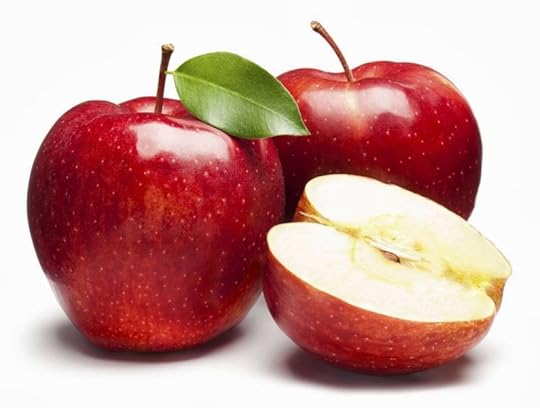
If you want to support my work or you learned something from any of my posts and want to tip me, my Ko-Fi is here! You can also drop me a donation to help me cover my website and podcast platform costs below via PayPal.
Make a one-time donationYour contribution is appreciated.
DonateMake a monthly donationYour contribution is appreciated.
Donate monthlyMake a yearly donationYour contribution is appreciated.
Donate yearlyDecember 31, 2023
2023 Wrap-Up
Greetings all, and happy new year!
This is my 2023 wrap-up post, many thanks to all who have supported me and made this the most successful sales year to date.
My top viewed post this year was my just-for-fun list of Werewolf Films 1910-1949, cw for anti-indigenous and anti-ziganist tropes in some of those. Other films mentioned also looked at the werewolf as a psychological condition, not a real transformation but a psychotic delusion, so there’s that too.
My lowest viewed post this year was my review of My Sister, The Serial Killer by Oyinkan Braithwaite, 5 out of 5 stars. I think that’s one of my favourite reads of 2022. It’s nice to see it squeak in as a post people have still found and read this year too!
As things stand at the end of 2023, my top 3 most viewed posts of ALL TIME are:
Rapunzel Stories – I have no idea what is driving traffic to this, but my all time most-viewed post is still my Rapunzel stories one, where I looked at a version of the tale and break it down into its main elements, with a few little writing prompts to think about diverse retellings, and some ideas to make the original ending less ableist. Werewolf Films 1960-1969 (the werewolf gets sexy)Welsh Vampire Lore and Vampire Lit (1940s to 1997) – I love this post, it was so much fun to research and write. You get the vampire chairs and bed in here too. What I Published (Books)My publications in 2023:
THE DAY WE ATE GRANDAD – the third novel in the Pagham-on-Sea series.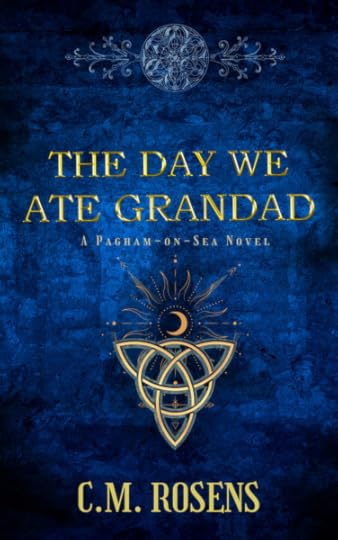
Three possible futures. Two versions of the apocalypse. One chance to save the world.
Wes Porter, a severely depressed insanity-inducing playboy, is detoxing from hallucinogens that have unlocked his ability to see versions of potential futures – and he’s just foreseen two ways the world could end. Normally, Wes would leave the hero bullshit to somebody else, but he can’t abdicate responsibility this time… not when both those apocalypses might be his fault.
With some prompting from a mythological bard-prophet who may or may not be real, and a lot of assistance from his monster-eating baby sister who desperately wants to move out of his apartment, and their soothsayer cousin who has his own demons to fight, Wes attempts to save [his] world… but have his poor decisions doomed them all?
THE DAY WE ATE GRANDAD is the third book in the Pagham-on-Sea series. It is a dysfunctional family cosmic horror novel for fans of WHAT WE DO IN THE SHADOWS, THE MAGNUS ARCHIVES, and THE CALL OF CTHULHU, with themes of bereavement and grief, generational trauma, and a dash of Roman/Welsh mythology.
THE RELUCTANT HUSBAND – a Lovecraftian pastiche novelette set in Pagham-on-Sea 1938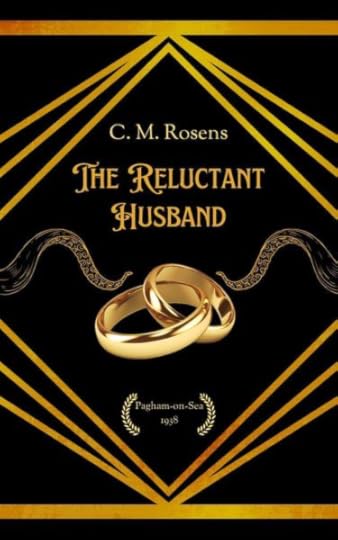
When Nathan Montague Porter, occultist and civil servant, catches the attention of Sir Jack Sauvant, he is invited to Sir Jack’s Sussex country house to attempt some grisly magical experiments. Little does he know that it is Sir Jack’s maid, Deirdre Wend, who actually holds the key to forbidden knowledge – but she won’t give it up unless he takes her to the pictures first.
A Lovecraftian pastiche for fans of Clive Barker and Ray Bradbury, a standalone prequel to The Crows.
This book contains implied scenes of a sexual nature involving tentacles, some graphic body horror (eyes, stomach, and transformations), rodent death/experimentation (not desciribed on-page) and cannibalism. It is written in British English in a style mimicking 1930s weird fiction.
What I Published (Audio)Season 03 of my podcast, Eldritch Girl: Weird Gothic Stuff & Nonsense came out this year and I’m very proud of it. You can listen to it on any platform you like, it should be there! It’s still hosted on substack for now but I’ll be migrating it back across to RSS.com when I can pay for the monthly fees.
My interviews for S03 were great, and you should definitely check out the filmmakers and authors and creatives featured this season. Catch up on all interview audio and transcripts here.
S03 also came with a bonus 3-parter on the end, which was the audio of The Sussex Fretsaw Massacre, chronologically after The Day We Ate Grandad but written before that book was completed and published. It actually came out Oct 2022. Get that as an eBook here, on Amazon, (just change the .co.uk part of the URL to your own preferred store) or discounted in my Ko-Fi shop.
What I Wrote (and Finished) Monthly fiction for my Ko-Fi Supporters , including some short stories and a continued series of letters that may form the basis for the plot of Book 4 in the Pagham-on-Sea series with the Porters and co. This includes some short fiction for Monstrous May! 18K first draft of Eglantine Pritchard’s backstory – free to Ko-Fi members to download. Sapphic crushes to lovers to enemies, Blackwood’s THE WILLOWS meets Machen’s THE WHITE PEOPLE in 1912 Wales. (They don’t stay enemies… they get an enemies to lovers arc and become life partners by the 1930s/40s). A second-world dark fantasy Beauty and the Beast reimagining – YELEN & YELENA is out with betas, and I’m revising the main side character’s arc so it’s more sapphic and happier for everyone at the end. Thanks to Nicole Carver for helping me with this! So this isn’t exactly finished, but I have 2 complete drafts, and I’m now on Draft 3.0, ready for professional editing and either shopping around as a dark SFF novel next year, or for self publishing. Let’s see. Dark Places , a horror short story I’m shopping around. Loads of rejections so far and no feedback, so I’ve revised and edited it and redrafted it, and it’s ready to go out again. What I Wrote (and shelved for now)I often start projects, get into a hyperfocus thing and then the interest dies out. This happens usually when I’ve answered the question that got me into the WIP to begin with, or when I’ve written the scene in my head that I really wanted to write. Then I just lose all interest in the story – even if I’ve written around 20K of it – and that’s that.
Shelved WIPs (for now) include ones that I’ve gone back over recently and ones that are still bobbing about at the back of my mind, so I might well go back to them.
Best Friends Bury Bodies – an experiment in “can I write a second chance romance”. The answer is no, not unless that’s a secondary plot and the main one is about murder, and very old friends rallying around an estranged member battling addiction and blackmail. Ellie Jenkins, Final Girl/Changeling WIP – this ended up in the Pagham-verse, not sure how, but I think it works there. A bored woman in a dead-end relationship that she can’t afford to leave suddenly wins the lottery thanks to some faerie influence, and discovers her relatives (and her bland boyfriend) will do a lot more than she bargained for to get their hands on her jackpot.A Funny Thing Happened on the Way to the Fortress – a second-world comic fantasy (not in Y&Y world, a different one based on Medieval Wales and the Marches), in which a grumpy, cynical, middle-aged henchman ditches his lord mid-climax as some hero or other makes his grand magical entrance, and legs it across the border to a rival warrior’s fortress – but gets abducted by a band of outlaws on the way. What I ReadI didn’t read a lot this year. I’ve really struggled. My GoodReads Year in Books is under my target goal of 20. I’ve bought a lot but just… haven’t managed to get to them. Ones I did manage to read:
Woe To Those Who Dwell on Earth by John Lynch
Quiet, Pretty Things by Megan Stockton
…And Nobody Knows it But Me by Megan Stockton
The Knock Knock Man by Russell Mardell
The Hacienda by Isabel Canas
We Are Here To Hurt Each Other by Paula D. Ashe
The Searching Dead by Ramsey Campbell
Annihilation by Jeff Vandermeer
The Twisted Ones by T. Kingfisher
The Hematophages by Stephen Kozeniewski
Home Before Dark by Riley Sager
A Novel Arrangement by Arden Powell
The Hellbound Heart by Clive Barker (and a lot of short stories in The Books of Blood but I didn’t log all these!)
Lesser Known Monsters by Rory Michaelson
Dark Woods, Deep Water by Jelena Dunato
I Feed Her To The Beast And The Beast Is Me by Jamison Shea
Skin Thief by Suzan Palumbo
What I WatchedA ridiculous amount of films, frankly.
My full list of Horror films watched for the 92 Days Challenge can be found here.
Films I watched for Horror Movies for the Holidays can be found here.
My posts on horror films I watched this year include: Welsh Gothic in Film: Darklands (1996), [CW for male rape in that film and its narrative purpose discussed in the post]; Here For The Horror (I) and Here For The Horror (II), with the bonus post Dirty Dozen to round off.
See You Next Year!That’s it for 2023. See you all next year for more Beauty and the Beast posts, and more fairy tale retelling recs. Looking forward to all of that. I will be joining in the 100 Horror Movies in 92 Days challenge again Aug-Oct, and who knows what else 2024 will bring.
Blwyddyn Newydd Dda, pawb.
Mutlu yıllar!
Happy New Year.
December 29, 2023
Beauty and the Beast in Horror Films
Greetings! Before I get into the main post, just a note on my newsletter/posts going forward.
Since I generally cross-post from my newsletter to my blog, and now that WordPress has a function that enables only subscribers to access certain posts, I’m going to start using that feature for my newsletter. I already didn’t like substack due to its stance on TERFs, but couldn’t afford to move the podcast off to a paid platform. I went on there originally as a stop-gap to save some money, but I really don’t want to be there more than necessary. I’m looking to migrate the podcast back to rss.com in the new year.
It also means less work to copy/paste and reformat things here, so I can just use WordPress for everything, and that will help a lot. So, going forward, some posts will be “newsletter” updates for subscribers only (but free), and other posts, like this one, will be set to public.
This means newsletters can be more interactive, too, like this post. To see what I mean, scroll to the bottom of this post to vote in my poll and decide which tale comes next – first collecting recommendations for retellings/reimaginings, then checking out how it shows up in horror films & horror books!
Beauty and the Beast as a Horror StoryI got really curious about how and where the BATB tale shows up in horror media, so I thought I would have a look. It absolutely lends itself to horror as a story – here’s Tommaso Larghetti’s edited trailer for the 1991 animation (Italian version) to show that it’s really all in the editing and emphasis. (I personally think this is better than the Editing is Everything version, but that’s good too).
This makes the animated version look way better imhoBe warned that SPOILERS LIE AHEAD!
First, let’s make some rules, because otherwise where BATB ends and Bluebeard begins can get very murky – not to mention Tam Lin.
For the purposes of this post, let’s agree that a Bluebeard tale is where Person A falls for charming, lovely Person B, but then it turns out Person B has a secret: a terrible, murderous secret, and Person A is next in line to be offed. Person A realises that they must escape Person B at all costs, and become the ‘Final Girl’. Examples of this might include Stephen King’s A Good Marriage (2014) dir. Peter Askin, based on King’s short story by the same title, Angela Carter’s The Bloody Chamber, Helen Oyeyemi’s Mr Fox, and T. Kingfisher’s The Seventh Bride. I think I’ll do more posts on this tale later! (Or sooner, if you vote for it below!)
A Tam Lin tale is where two human lovers are tested by the transformation (usually grotesque and dangerous) of one of them, and the other must hold on to them regardless of what they turn into, in order to save them and restore their humanity. Horror has plenty of failed Tam Lin tales, where the lover cannot hold onto their loved one through the transformation, and cannot save them.
A BATB tale is where Person A meets someone [Person B] whose monstrosity is on full display from the get-go, and yet a relationship forms anyway.
In more detail for BATB we may also see the following elements/themes:
Something in the narrative functions as a ‘curse’ for Person B – perhaps not literal, but a reason why they are this way, or a compulsion they have, or something they wrestle with. They may claim that Person A’s love has been transformative for them, or a transformation might actually occur for Person B (and also Person A, whose own views and perception may change through the course of the story). Person B may also be persecuted and hunted by others as a result of their monstrosity (real, or perceived), causing Person A to evaluate their loyalty. Examples of this might include classic Gothic novels like Charlotte Bronte’s Jane Eyre, or modern fiction like A Dowry of Blood by S. T. Gibson, and films like The Shape of Water (2017) dir. Guillermo Del Toro, and a host of the retellings and reimaginings in my previous post.The addition of a ‘Gaston’ character as a foil for the Beast and a choice for Belle to reject in favour of the Beast is a later addition meant to help change the dynamic so it’s not so ‘girl falls for her captor’ centred. BATB retellings may or may not include a love triangle, but this element isn’t essential to the tale.
In Romance, stories must have a Happy Ever After (HEA) or Happy For Now (HFN) ending to qualify as part of the romance genre. In Horror, this doesn’t have to be the case. Horror can use elements of these tales and subvert them to create a number of variations, and the ending does not need to be happy.
With this in mind, a lot of horror blends both BATB and Bluebeard, so it can be hard to tell what counts as which tale. I was pondering if Crimson Peak (2015), Ready or Not (2018), The Invitation (2022), and Ile Owo/House of Money (2022) count as BATB tales, for example, but I’m pretty sure they are all solidly Bluebeard stories (arguably with some strong BATB elements!). So I’ll post about them in the Bluebeard post instead when we get there.
Meanwhile, I think that Slither (2006), The Fly (1986) and Nightbreed (1990) are actually Tam Lin tales. I’ve included them below though, as there is some crossover, and I’m not sure yet if I’ll do Tam Lin on its own.
But don’t worry – there are lots of horror BATB versions out there.
Here are a few.
Beauty and the Beast Horror Versions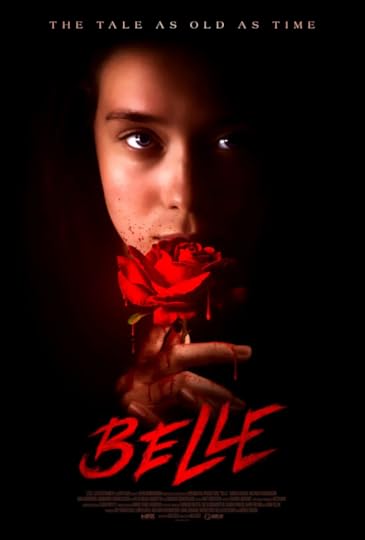
Belle (2023) dir. Max Gold, is a Gothic Horror that came out in the US in August 2023, and went straight to VOD platforms apparently, but I still can’t see it anywhere in the UK so I’m waiting for it to reach us.
Filmed in Iceland with some amazing cinematography, this version has Belle as a farm girl desperate to save her ailing papa via a magic rose – but to get it, she has to give herself to a cursed man with a taste for human flesh. I’m dying without this movie. I need it in my eyes.
Wicked Horror has a list of 7 horrific takes on Beauty and the Beast in movies, and I found another post here with some I agree with, particularly the Phantom of the Opera retellings as these are all basically using BATB elements (as was Gaston Leroux in his original Gothic Horror novel, I would argue, some of which include sexual assault and dub-con so be warned as I mention this below). I also threw out more rec requests, and this is a list of some of them!
I have highlighted others that I thought I could go into more detail about, and some of my own favourites, below. Feel free to disagree with my reasoning though, I was just having fun, and if you’ve got more please do add them in the comments!
These include:
The Phantom of the Opera (1925) dir. Rupert Julien – I’m going to include all versions of PotO here, to be honest, with particular emphasis on The Phantom of the Opera (1998) dir. Dario Argento – in which the Phantom is not disfigured at all, just raised by rats. Rats that he sometimes puts down his tight trousers and lies back with a smile on his face. No, really, that’s a scene. He also fucks Christine and then rapes her when she realises he’s a killer she can’t change. I would also add in The Phantom of the Opera (1990) dir. Tony Richardson – Charles Dance understood the assignment. This, like all the others and including the musical version and its own film, The Phantom of the Opera (2004) dir. Joel Schumacher, all have the love triangle between Christine, the Phantom, and Raoul. Christine goes for Raoul in all of these, which is the equivalent of Belle going for Gaston, I guess, or splitting the Beast into his 2 parts – Beast and Prince, so she gets the better of the two halves. So it’s still BATB, but this time, the Beast figure in the story does not get the girl, and dies/disappears. King Kong (1933) dir. Merian C. Cooper & Ernest B. Schoedsack, in which, famously, “beauty killed the beast”. This is definitely echoed in its later remakes, King Kong (1976) dir. John Guillermin, King Kong (2005) dir. Peter Jackson, and Kong: Skull Island (2017) dir. Jordan Vogt-Roberts. and probably all the other versions in between. Beauty and the Beast (1946) dir. Jean Cocteau, which is the dreamy, Gothic Horror-esque version that inspired a lot of choices in the 1991 animation. I do love the scene where the Beast is prowling around covered in fresh blood from his kill that is steaming into the air.Beauty and the Beast (1962) dir. Edward L. Cahn on a low budget, where the Beast is literally a werewolf/wolfman, and that’s the curse.Panna a Netvor (1978) dir. Juraj Herz – dark fantasy Gothic Horror version, which I fully love and is one of my favourite adaptations, hands down.Swamp Thing (1982) dir. Wes Craven is pretty much a BATB tale, essentially. I would also argue all versions of The Hulk where he gets a lady friend are kind of BATB plots too in their own way.Beauty and the Beast (1984) dir. Roger Vadim, which cast horror actor Klaus Kinski as the Beast, and is meant to be pretty scary for kids? I didn’t see it as a kid, but I think I would have loved it.Henry: Portrait of a Serial Killer (1986) dir. John McNaughton – a dark, bleak twist on BATB, where a woman falls for a serial killer (she knows he’s a murderer from the start). Very dark romance, very grim. CW for sexual assault.Edward Scissorhands (1990) dir. Tim Burton is definitely a Gothic BATB for the weird kids. I loved this when I was a kid/teen then sort of outgrew it, I guess? Vincent Price is a gem, though. Meridian (1990) dir. Charles Band, in which we get a love triangle with cursed twin brothers, and monster-fucking in a gothic Italian castle but with some very uncomfortable dub-con/SA overtones. The twin brothers here very much do symbolise the 2 parts – Beast and Prince – and that’s part of the love triangle. Jenifer (2005) dir. Dario Argento, is a genderbent version in which, from what I can gather, a facially disfigured (and possibly demonic??) woman is rescued by a cop, and ends up literally eating his kids, but the sex is so good he doesn’t mind. The 00s were a wild time. Slither (2006) dir. James Gunn – the love story in the film is argued to have strong BATB elements and could be seen as BATB in reverse, like Cronenberg’s The Fly, as it survives his transformation into a monstrous, mutated version of himself. Possibly not a BATB film and more of a Tam Lin tale (I go into more detail about BATB vs Tam Lin in the section below where I ponder if we can count Cronenberg’s The Fly.)Spike (2008) dir. Robert Beaucage, which is meant to be surreal and Angela Carter-esque, but since this is a US-made, low-budget 00s film, I’m guessing that it’s got its flaws beyond fridging one half of the lesbian couple…Låt Den Rätte Komma In/Let The Right One In (2008) dir. Tomas Alfredson – I can definitely see the argument for this being a genderbent BATB story. This is based on John Ajvide Lindqvist’s 2004 novel, and in both the novel and Alfredson’s film, Oskar discovers Eli, the girl next door, is a vampire. There’s a good article on Fangoria about the positive way the film approaches the relationship between Oskar and Eli, and Eli’s gender identity vs her vampire identity compared to the novel, from a trans perspective. Warm Bodies (2013) dir. Jonathan Levine – basically YA BATB with zombies. The Shape of Water (2017) dir. Guillermo Del Toro – I’ve already mentioned this one, but it’s on the list of suggestions I found as well so it’s going in the list! Aquatic monster love in 1960s USA.I’m sure there are a lot more – I’ve already done a post with my favourite film versions,which includes Panna a Netvor.
But what about other horror films? Where else does it show up as a theme?
Beauty and the Beast Horrormance HighlightsThe film that springs immediately to mind as an example of this is Beast (2017) dir. Michael Pearce. It’s psychological horror, and this masks the themes a little, but they play out under the surface.
The abusive, suffocating relationship that an isolated woman in a small island community has with her mother is horror enough, but there is a serial killer stalking the island’s teenage girls, and it could well be the attractive guy she has just met. In fact, everybody tells her it’s him. There’s even some evidence that it’s him. But she decides that she doesn’t want this to be true, lies for him, and plans to run away with him. Except… well. Guess what. He confesses to her, confirms that everything he’s accused of is true (and he thought she knew that), and says that her love has been transformational for him. She does not respond well.
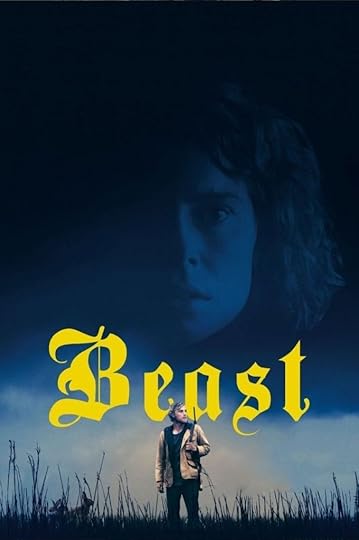
This is definitely intended to be a contemporary Beauty and the Beast tale – the clue is in the title – and she was never in any danger from him (unlike the Bluebeard narrative). He’s an outcast, like her, and treated badly by the community as a result, which is what endears him to her in the first place. It has a much darker ending, but it is also pretty empowering for her, I guess, and I really liked it.
But it doesn’t end there. What about when the protagonist falls in love with an actual monster? That’s more what we’re talking about, right?
My favourite genderbent version of this is Spring (2014) dir. Aaron Moorhead and Justin Benson.
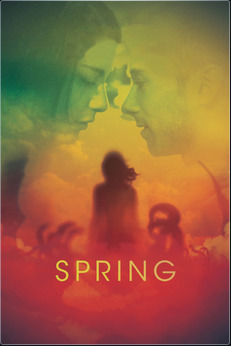
It’s fairly obvious it’s a wish-fulfillment fantasy film (whomst among thee wouldn’t want an immortal primordial monster lady to give it all up for them while visiting the remains of her family in Pompeii under the shadow of Vesuvius????) but I did enjoy it.
It was one of my #100HorrorFilmsIn92Days watches and very worth it. I don’t think it quite made it to my top 10 but it’s definitely in my re-watch list.
There are also some great body horror films where this trope could be said to come into play, but subverted. What about when the love interest transforms into a Beast – what then for their lovers?
The is where we could maybe argue for David Cronenberg’s The Fly (1986) and a lot of werewolf and vampire romances being essentially Beauty and the Beast plots – The Fly being one in reverse, like Slither.
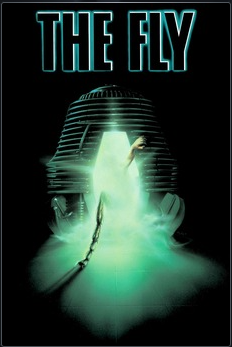
But The Fly is more than a BATB inversion – it was interpreted as a doomed romance for the AIDS generation, two star-crossed lovers “torn apart by a voracious, unstoppable disease”, but Cronenberg himself interpreted it as a metaphor for aging, “a compression of any love affair that goes to the end of one of the lover’s life.”
BATB is in itself a tale of two lovers separated by the physical form of one of them, who can only become a true mate for the other by the power of transformation, so The Fly can certainly be said to be the reverse of that. Whether it really counts is up to you, I think. I wonder if it isn’t more of a Tam Lin type of plot, and if Slither would therefore fall into this category too, where the lover holds on to their loved one while transformations rob them of their humanity. At the end of Tam Lin, having successfully held on, the lover is reunited with Tam Lin in his human form. But in horror, sometimes you have to know when to walk away (or shoot whatever your loved one has become).
Here is a thoughtful article on the romantic tragedy at the heart of The Fly, by Gena Radcliffe, and below is the trailer for you to enjoy.
Another film I think does count is Outcast (2010) dir. Colm McCarthy, which I read as a Beowulf reimagining set on an Edinburgh council estate. It’s also got references to Titus Alone by Mervyn Peake (the book given to Fergal by his mother in the film), and there are some strong parallels with that plot, too, and the decisions Fergal (the Titus figure) is being expected to make.
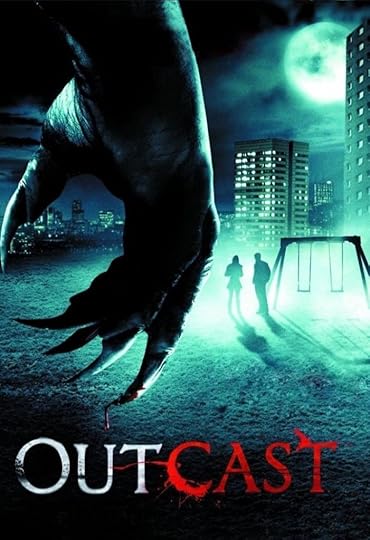
In this film, a Scottish witch clan led by Laird (James Cosmo) is tracking down a monster and his mother Mary (Kate Dickie) via a ruthless Irishman, Cathal (James Nesbitt), who is in this for the power he will receive in the process. The idea seems to be that these clans still thrive on ancient and vaguely defined magic systems, and are specifically ‘Celtic’ in nature. Cathal is the ‘Beowulf’ figure (hero of the Geats) coming to the aid of Laird’s clan (equivalent of Hrothgar, King of the Danes), to save them from the monster that has been engendered by an unsanctioned union.
Cathal/Beowulf is fighting Fergal/Grendel’s mother (Mary) to get at Fergal/Grendel in the first place, but the creature design is suitably slimy and monstrous, as hinted at in the poster above. There is a battle of wills between Cathal and Mary where they both strip naked by candlelight, miles away from each other, and fight each others’ blood magic in their respective rooms, eyes closed and sweating profusely, which I absolutely loved for lots of reasons – plot, foreshadowing, backstory, etc. Plus, it’s an amazing low-budget way of getting around CGI magic battles, which this film absolutely didn’t need.
This has a Beauty and the Beast subplot between Fergal and Petronella, a girl from the estate he moves into when seeking sanctuary from his pursuers, but the romance is once again doomed by the fact they’re in the wrong genre. Plus, once it’s clear we’re also in a Beowulf reimagining, it’s not going to be a happy ending for the Grendel figure, is it. The enchantress, and reason for the curse (although in this case she didn’t mean to be), is Mary his mother, and she keeps him locked away from the world and constantly on the run, isolated and lonely. Her magic also protects him from the outside world and the hunters coming for him.
Petronella isn’t forced into contact with him like Beauty is in the tale – he literally moves into the flat next door, so it’s more a forced/accidental proximity type situation, and the teen romance unfolds like a paranormal/werewolf romance, with the same beats.
I enjoyed the worldbuilding in this, and the urban, gritty magic of using dead birds as compasses, and skin magic (tattoos that bestow powers on the person who is inked) and using the skin and blood of a corpse from the morgue as a more specific form of locating the mother and son in a kind of necromancy ritual.
This one might be contentious for the BATB themes, but the trailer is below.
I would contend that Clive Barker is a good choice to look for some Beauty and the Beast plots. Hellraiser (1987) and Nightbreed (1990), both of which he wrote and directed, have BATB elements to them.
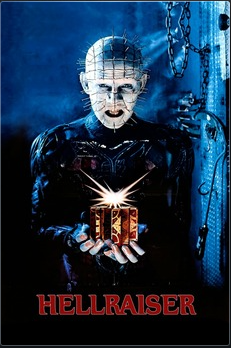
In Hellraiser, Julia’s love/lust/very complicated horny feelings for Frank is the reason she helps him (the Beast figure, in full raw and dripping monstrosity) lift his curse, which he has put on himself through his selfish pursuits of pleasure. The box is the cursed rose, a ticking timebomb now that it’s been reopened and the Cenobites are seeking him. Except… things do not go Frank and Julia’s way.
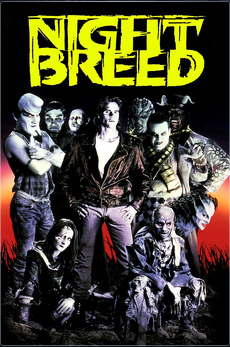
In Nightbreed, Lori loves Boone so much she’d do anything for him, which includes sticking by him when he’s in full Beast mode. Again, this one is more Tam Lin than BATB though, I think, but it’s certainly got a lot of BATB elements in it. This also has the Monster Hunt trope present in the influential 1991 version of BATB, and the terrible consequences of prejudice against the monsters hidden in Midian from the world.
I think a lot of Barker has these elements, or things recognisable as Beauty and the Beast elements, so I think he will appear on a the list of Beauty and the Beast in Horror (the final post in this mini-series).
Lastly, I think I’d put Gothic slowburn horror The Lodgers (2017) dir. Brian O’Malley as a genderbent BATB tale. The protagonist Rachel occupies both Beauty and Beast position in the narrative, and veteran of WWI, Sean, is the one who finds himself endangered by her, her crumbling estates, and its dark, cursed secrets.
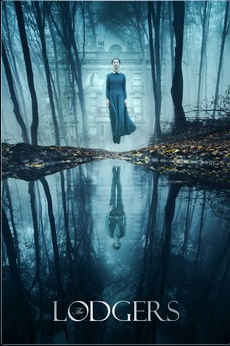
This is a ghost story, and a tale addressing the Irish relationship with its Anglo-Irish colonial past, and Rachel and Edward are symbols of this decaying elite. Sean occupies the “Belle” position of social outcast in his village due to the fact he fought for the British in World War I, and has returned from the Front, traumatised and disabled. He falls for Rachel, but the curse upon her family proves to be his undoing.
Rachel flips between Beauty and Beast in this narrative, as her own Beast is her twin brother, and the creepy voices of the Lodgers the twins seek to appease. Her transformation comes in the realisation only she can break the cycle, and the curse, and that this freedom cannot be given to her by an outsider. She cannot be rescued, she can only harm and destroy – she must rescue herself (and by doing so, free the villagers of her presence and curse) by breaking the cycle and leaving the estate altogether.
While there is a romantic subplot between Rachel and Sean, this is not really a romance, and it doesn’t end well. Not all BATB horror films have a romantic plot thread, though!
Beauty and the Beast: Not Always a RomanceOne of the films that stands out to me as a BATB relationship (but not a romance) is the Finnish coming-of-age horror, Pahanhautoja/Hatching (2022) dir. Hanna Bergholm. This relationship is not just between Tinja and Ali – it’s within Tinja herself, and this is the externalised metaphor of struggling to emerge from her metaphorical shell and into the rebellious phase where she becomes something else.
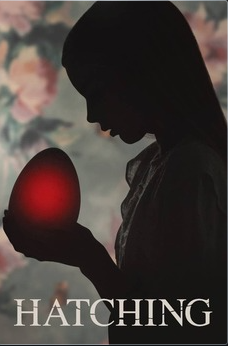
The depiction of the central relationship is so interesting and nuanced, and this is one of those films where the lines between beauty and the beast are blurred effectively. I really enjoyed this one, and it was one of my most memorable watches for 2023’s #100HorrorMoviesin92Days.
This has everything including a death/resurrection at the end, and the surreal, complete and slow transformation of the Beast figure throughout the film, and the theme of love is transplanted from romantic love to familial and parental love, and also the theme of self-love.
I think this works really well.
Arguably, if we’re going down this road, Black Swan (2010) dir. Darren Aronofsky counts too. The parental relationship is twisted and abusive, so the home life of the protagonist throws her into the arms of The Beast in the way Belle’s father does in the tale.
In this instance, the Beast is the ballet itself, and the role of the Black Swan which the protagonist is desperate to dance.
Unfortunately, the protagonist’s deep devotion to her art cannot save her from the curses of obsession, jealousy and blind ambition.
This has body horror, obsession and Gothic drama, and the transformation of the protagonist into the darker side of herself is movement from Beauty to Beast to both at once. There is even the climactic scene, where the curse of obsession has fully taken hold and the protagonist’s transformation is transcendent and complete.
This could be read as a BATB subversion, as the lack of love in her life for anything other than ballet, which is in itself a warped and cruel kind of love by the end, dooms her. This love is not just a lack of romantic love, but also parental/familial love, and platonic love. She is very isolated and alone throughout the film, and with nobody to pull her out of her spiral and ground her, or give her the self-love and self-esteem she desperately needs (more than just to perform a role), the BATB curse – if you cannot love [someone] and be loved [by them] in return – results in the dramatic tragedy of the film’s climax.
Finally, I think I’ll also count Slapface (2021) dir. Jeremiah Kipp, as this one also puts the site of horror as the family situation in the protagonist’s home. Like Black Swan, it’s the whole horrendous home situation and lack of support there, primarily the undermining of self-esteem and stability, that leads the young boy protagonist to befriend his Beast – this time, a monstrous witch-demon who lives in the woods.
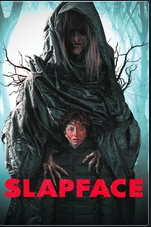
The young boy, trying to fit in and impress the girls in his class (who bully him), is being raised by his alcoholic older brother. Both are traumatised by the deaths of their parents, and the older brother has little to no support for his own mental health and addiction issues. The single ray of hope is his girlfriend, but that doesn’t go so well when she has a run-in with the monster that the little boy has befriended in the woods. In fact, the monster becomes the boy’s undoing, as its nature cannot be transformed – rather it is the embodiment and twisted mirror image of the rage the boy feels for his whole situation.
This isn’t a perfect film and it has its issues, but it tries, and I appreciated what it was trying to do. Some bits it nails, and they are the bits that were a proper gut-punch, like the kid trying to have a serious emotional conversation with his only parental figure, the older brother, who is sitting in the cold bath with his clothes on, drunk. There are so many bits of it that still haunt me. It’s a good double-bill with Hatching if you want to dive into a depression spiral and never come out.
That’s a Wrap!In my next post I’ll be thinking about how Beauty and the Beast shows up in horror books (novels, novellas, shorts) and classic Gothic novels, but after that I’ll check out another fairy tale. You can choose by voting in the poll below!



